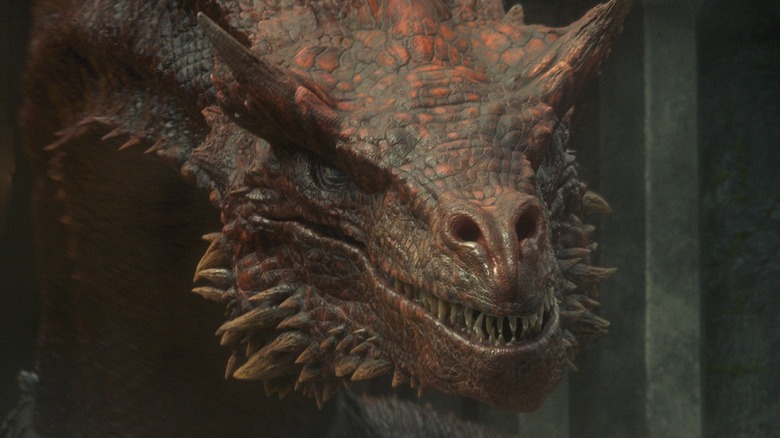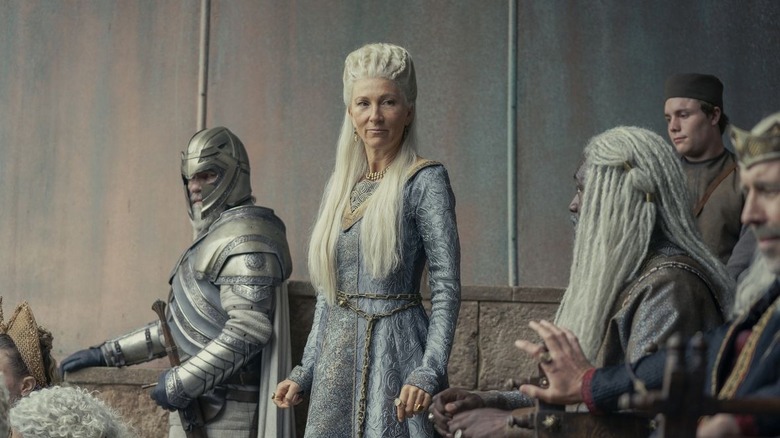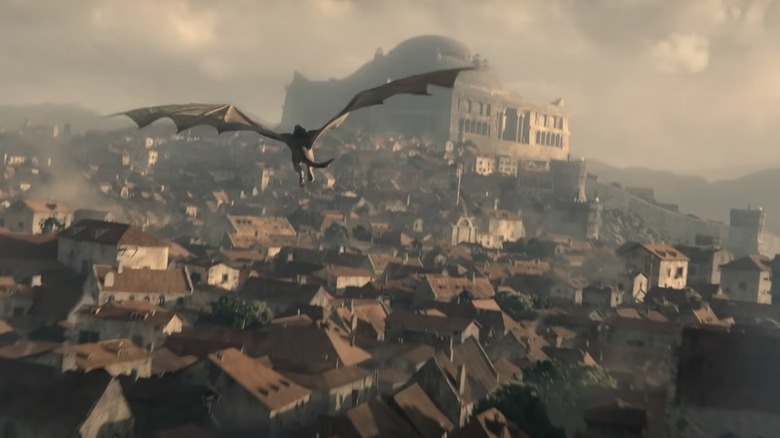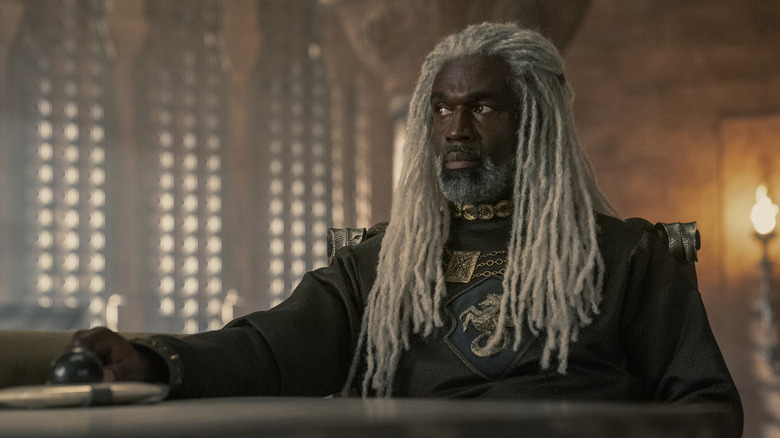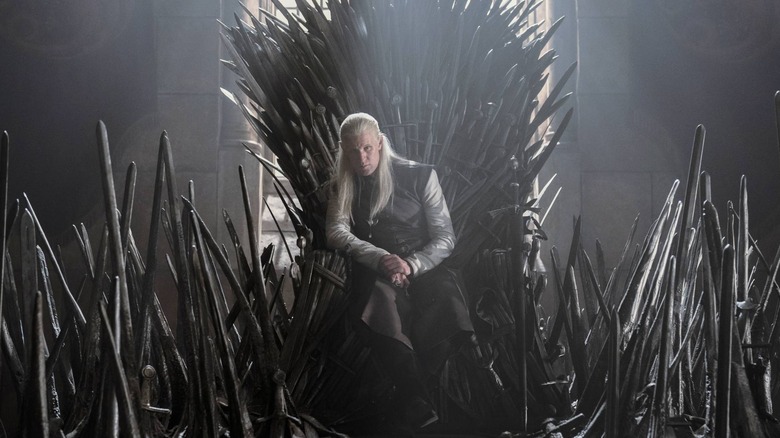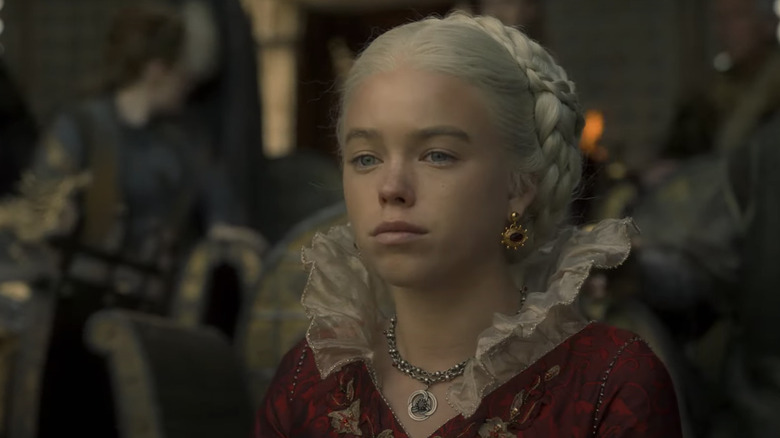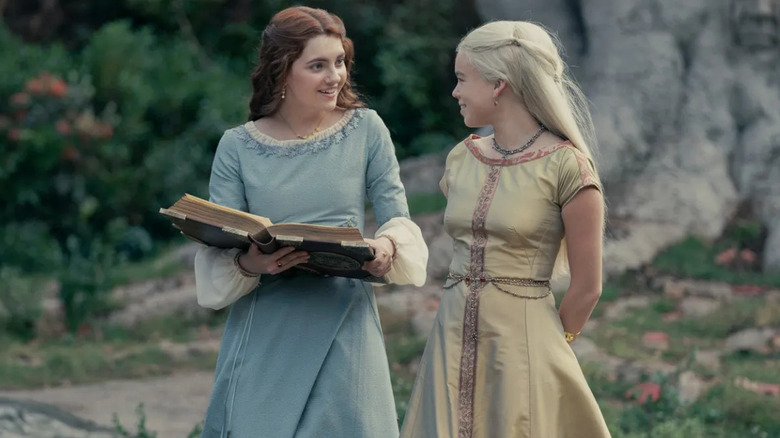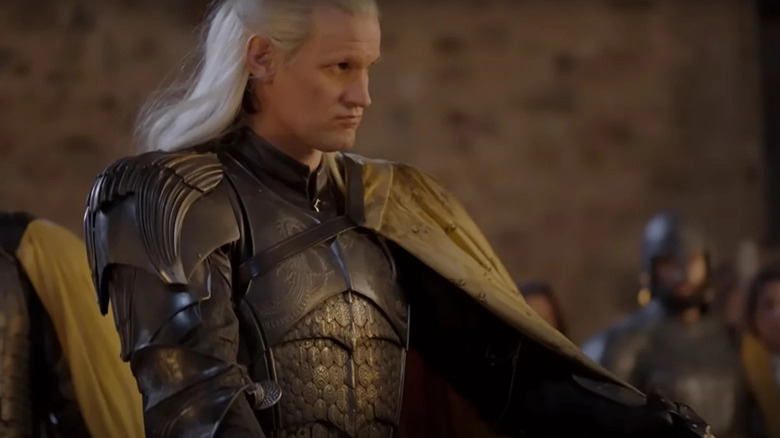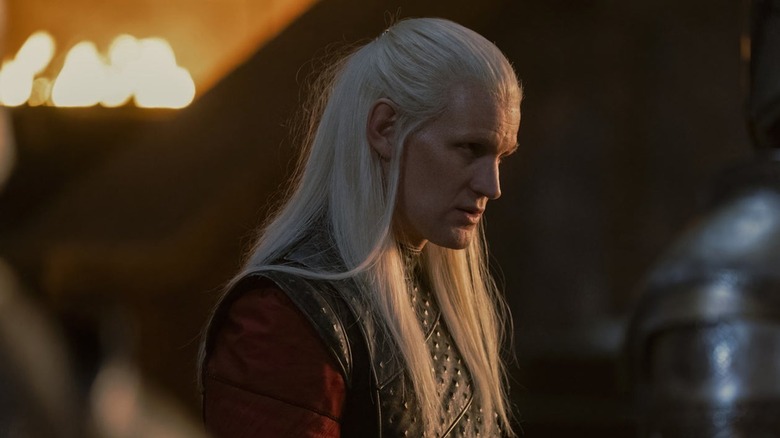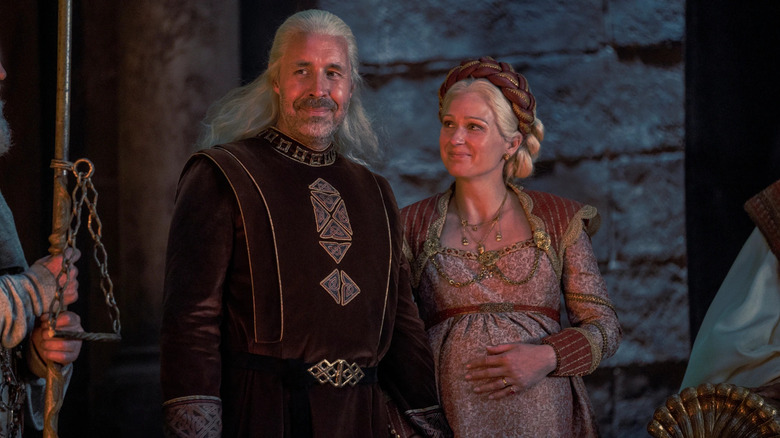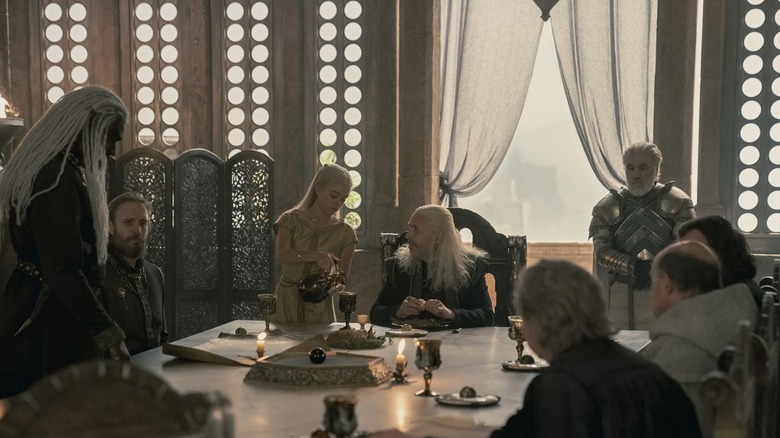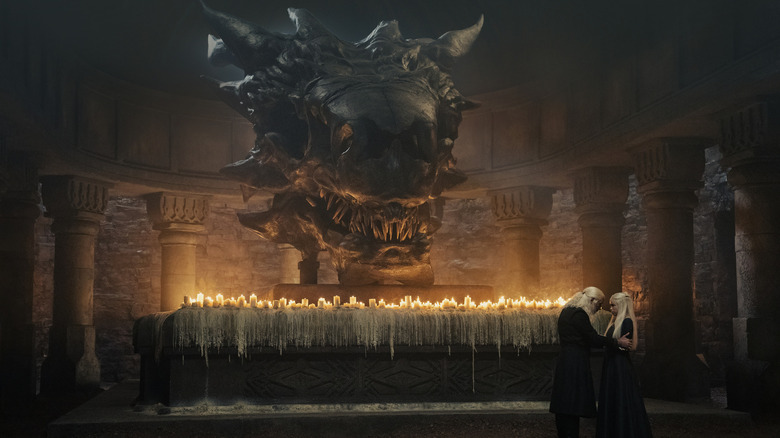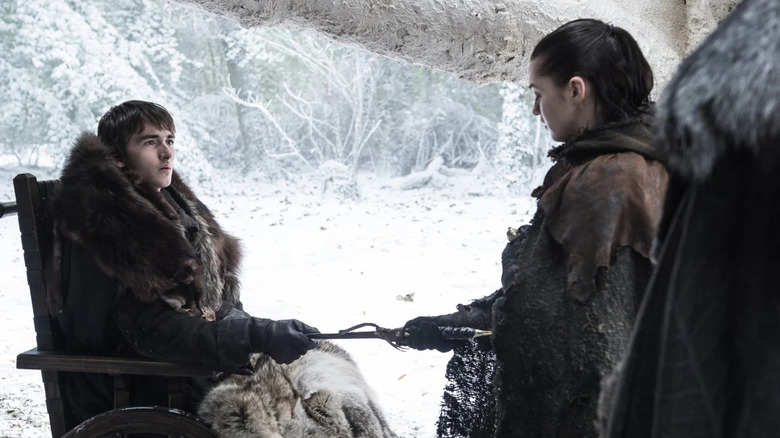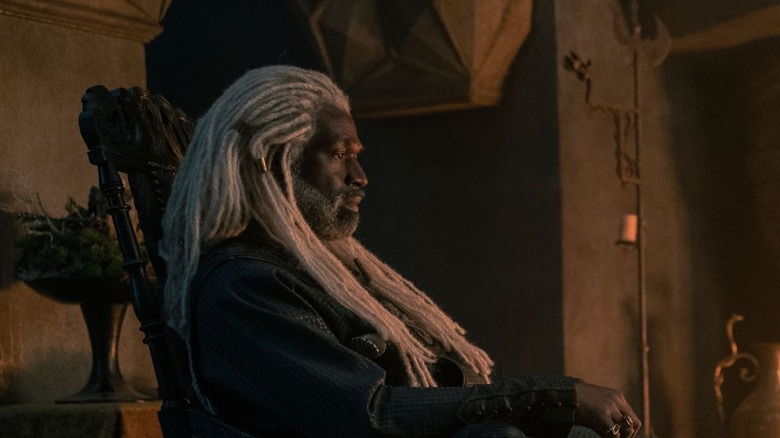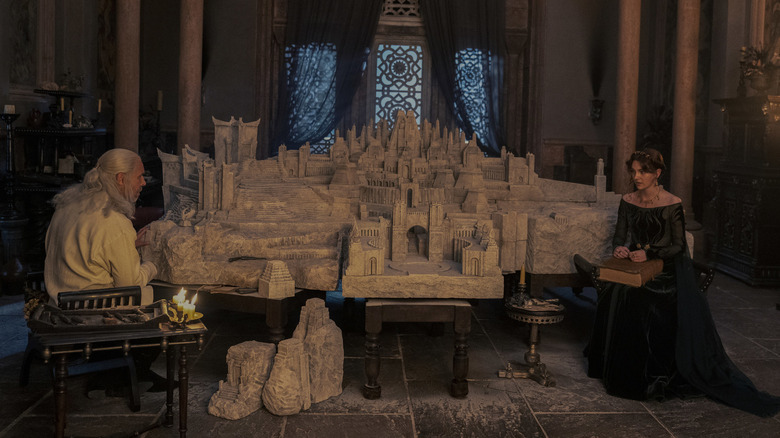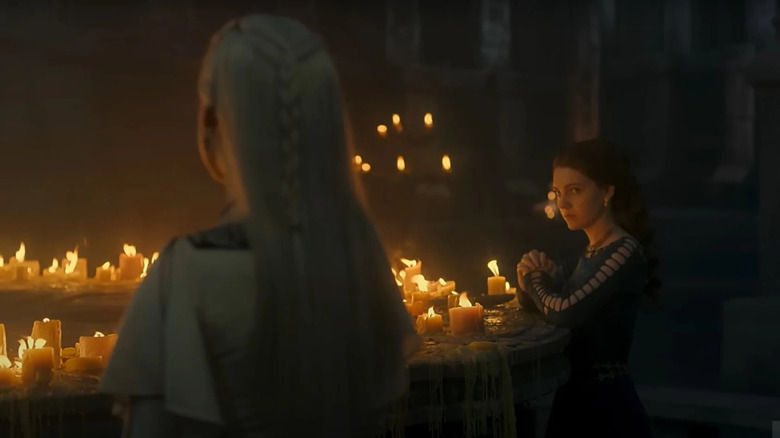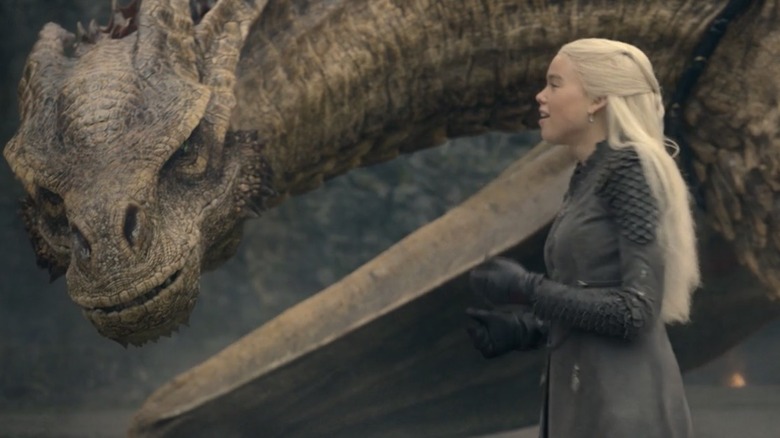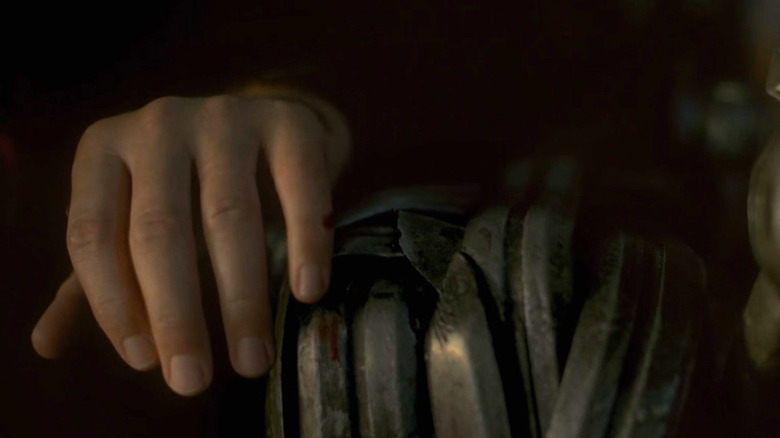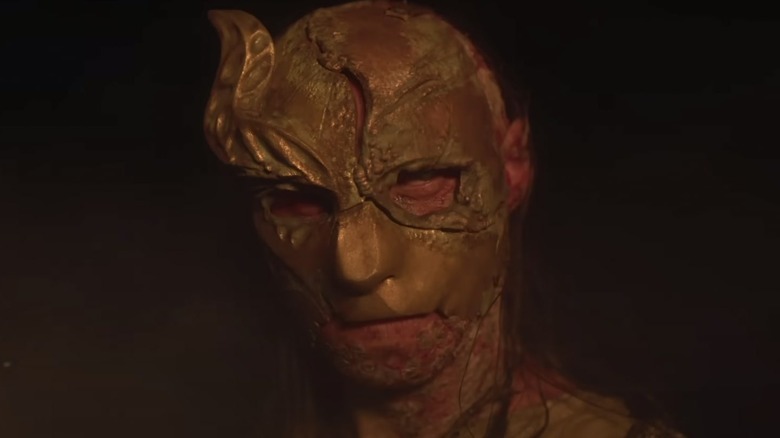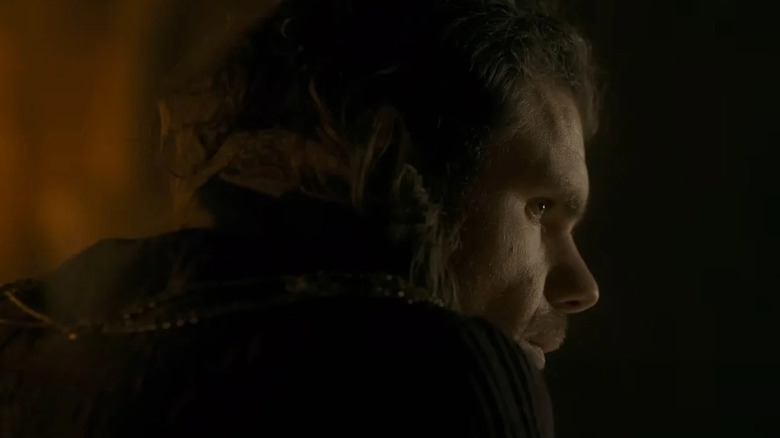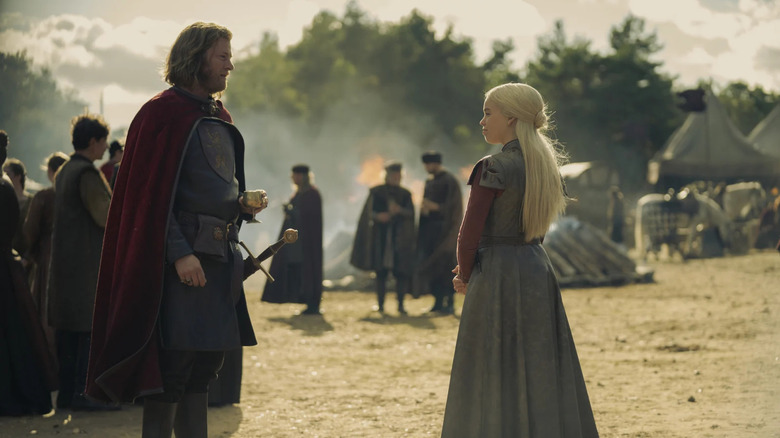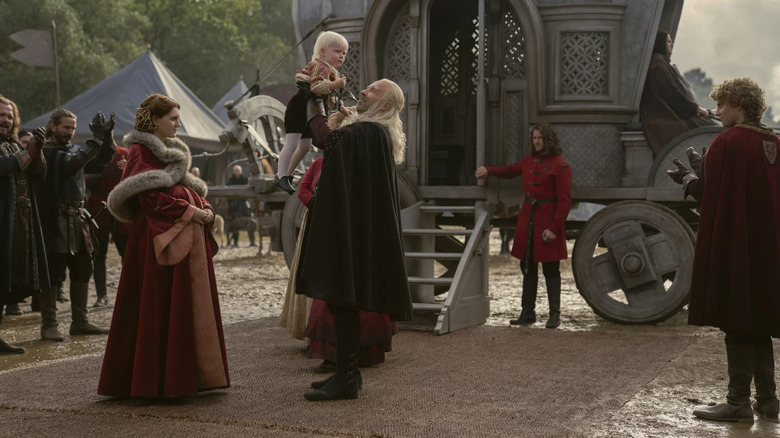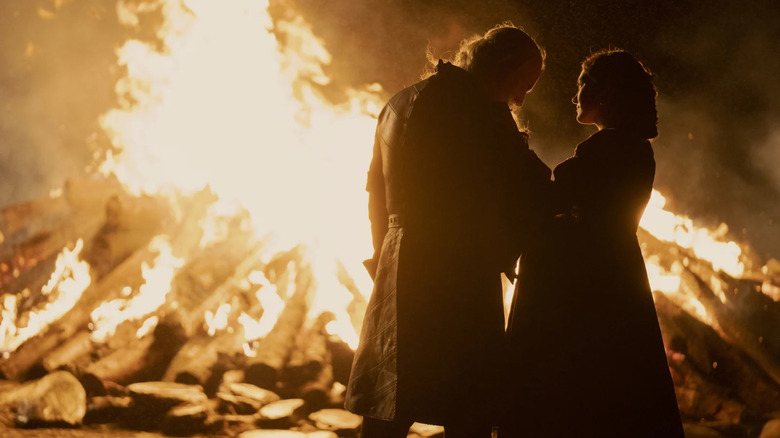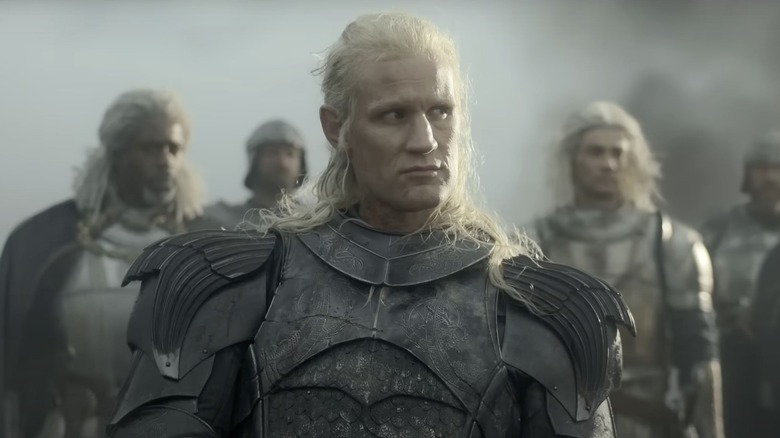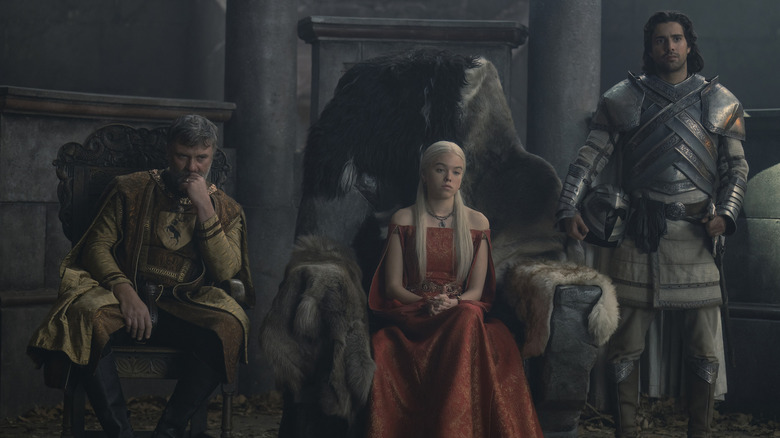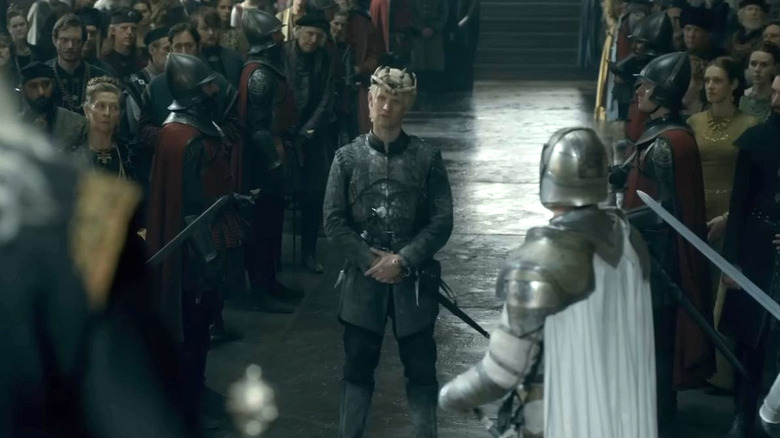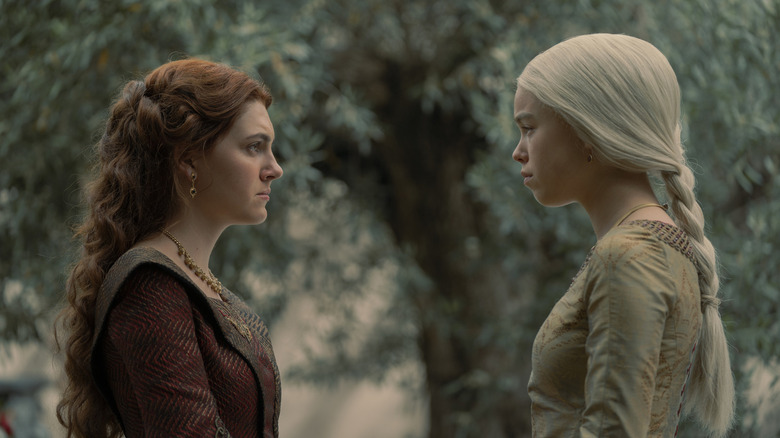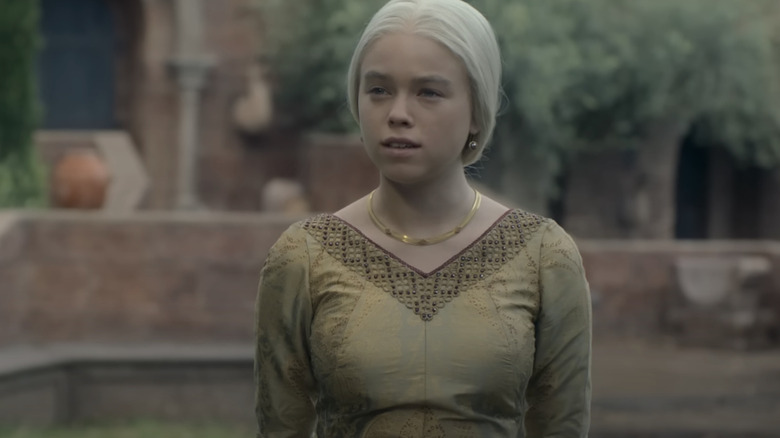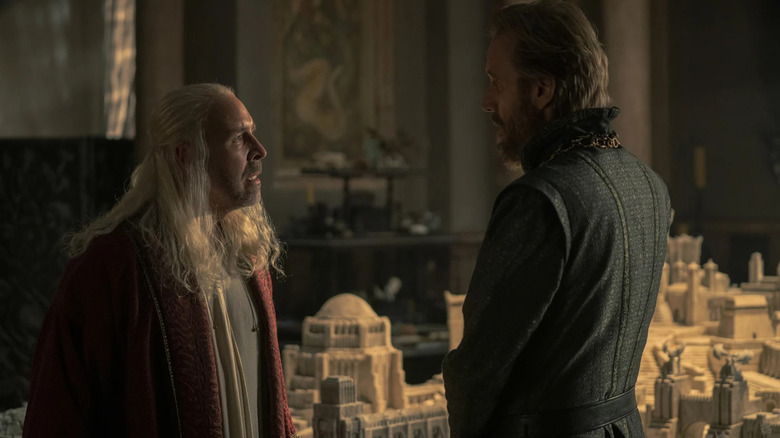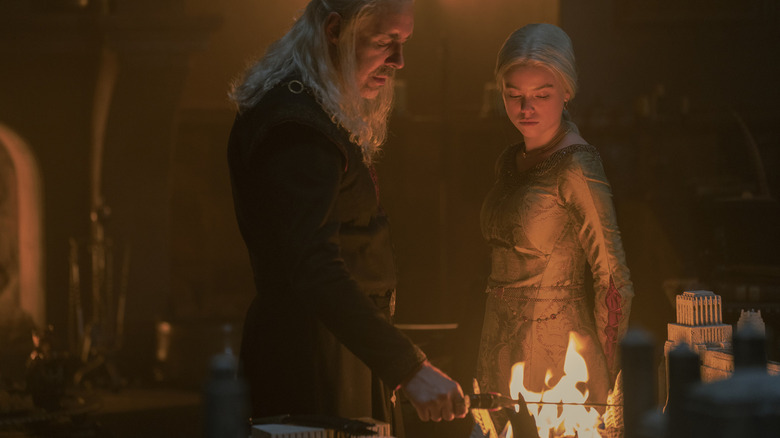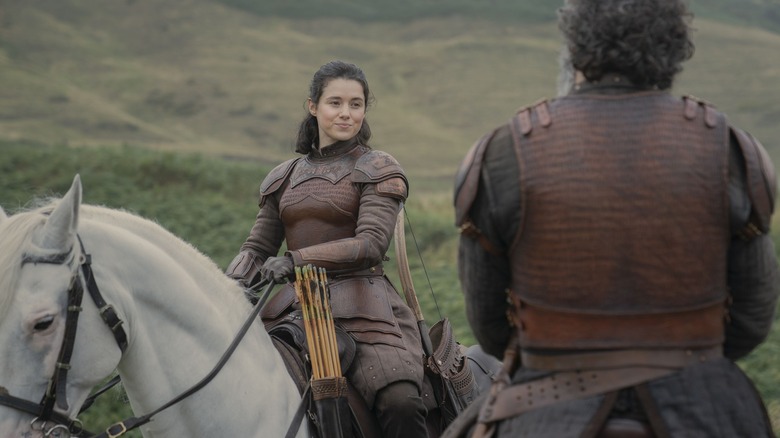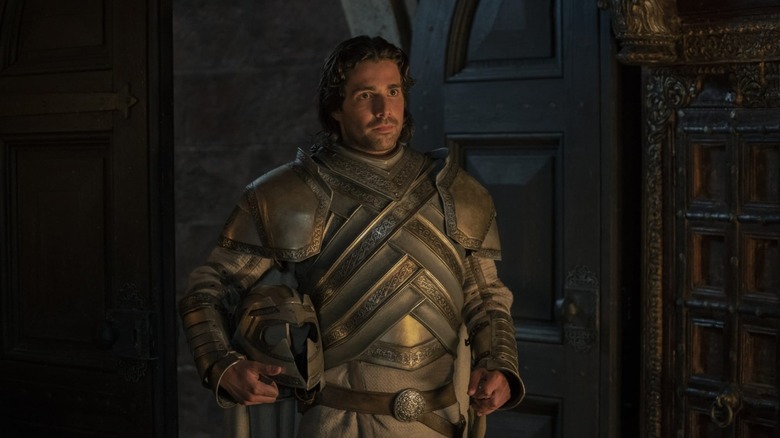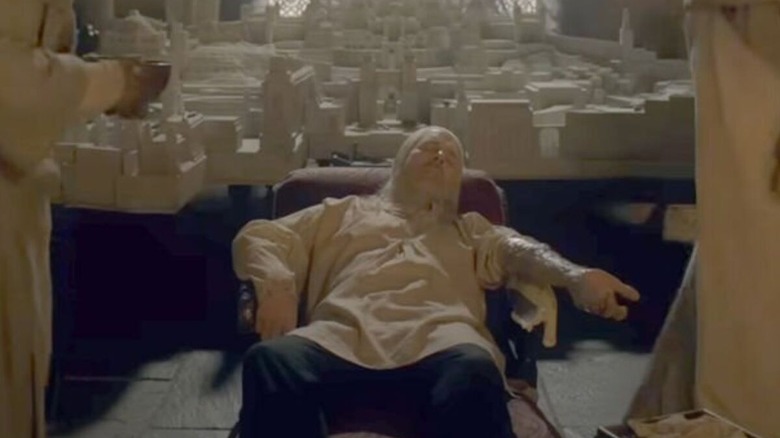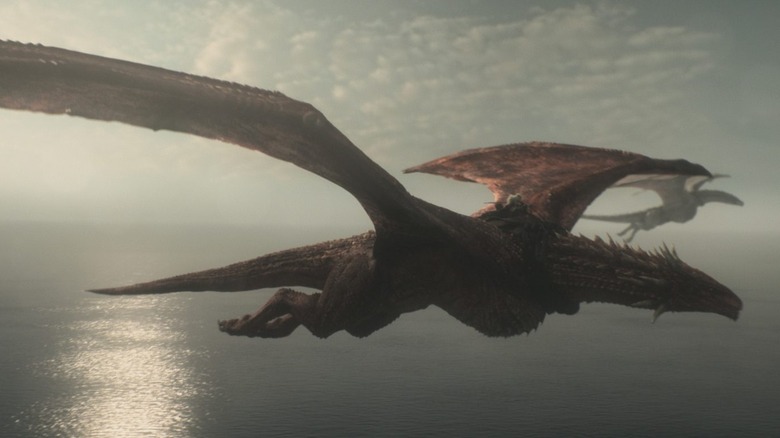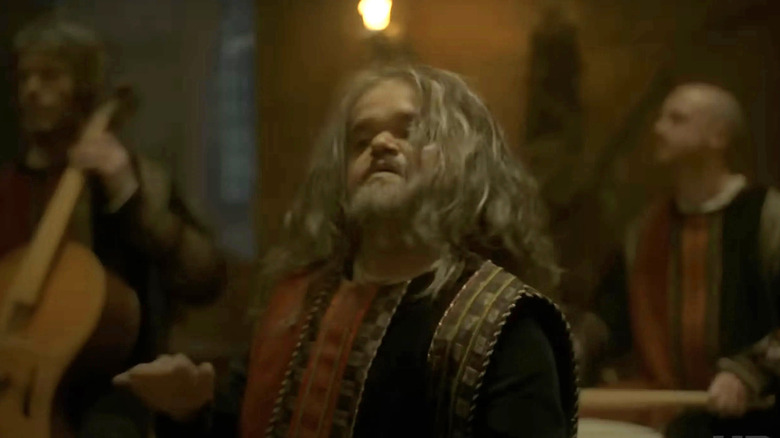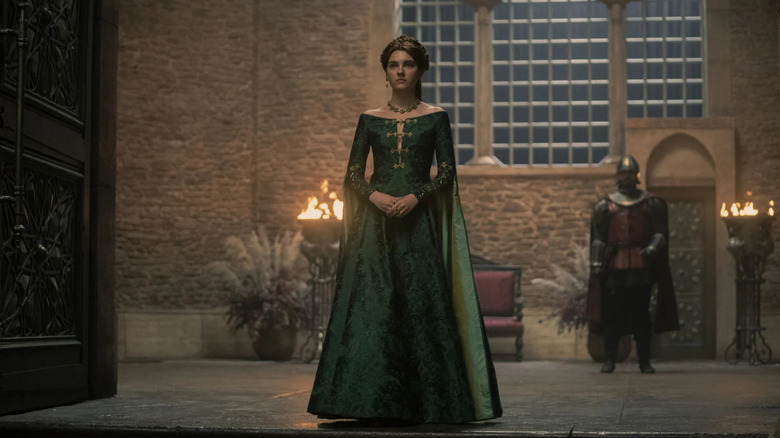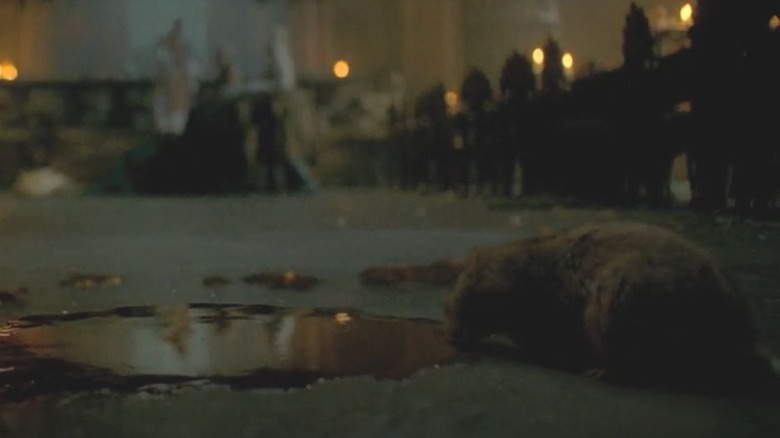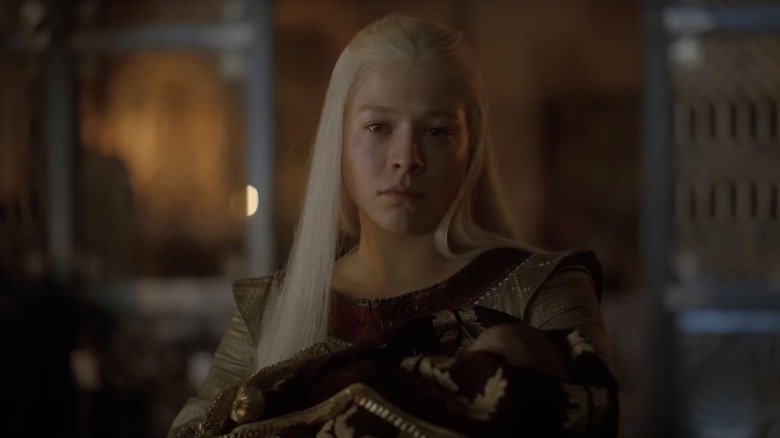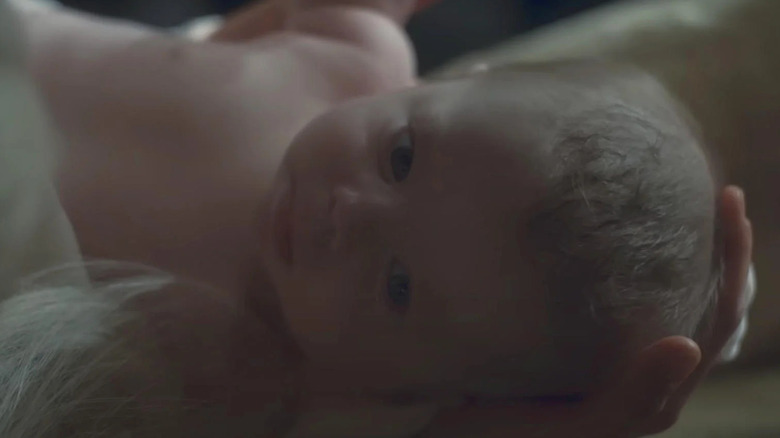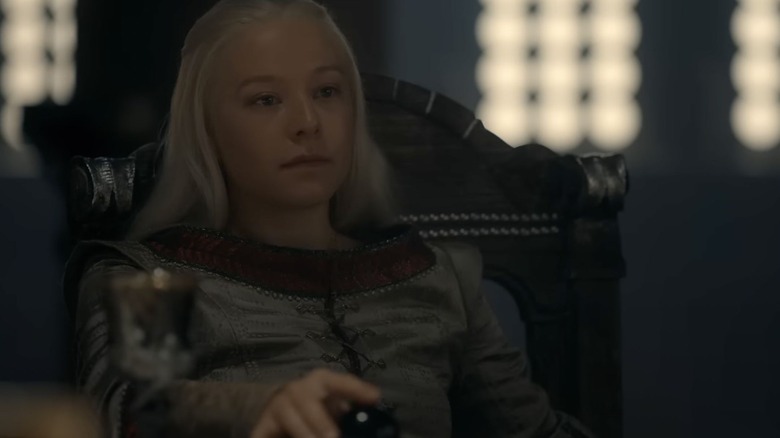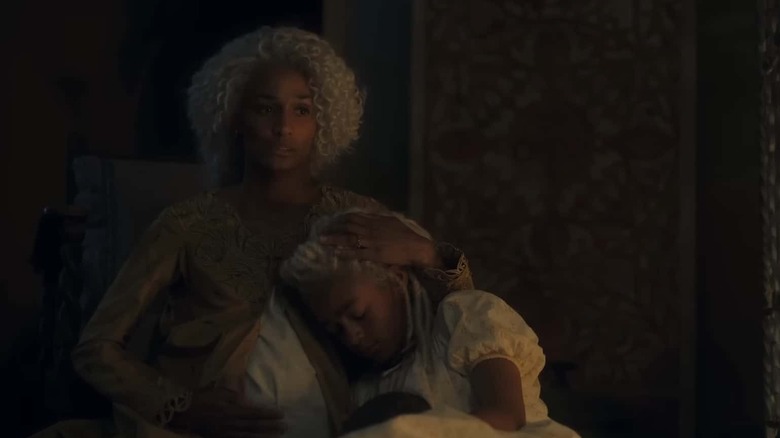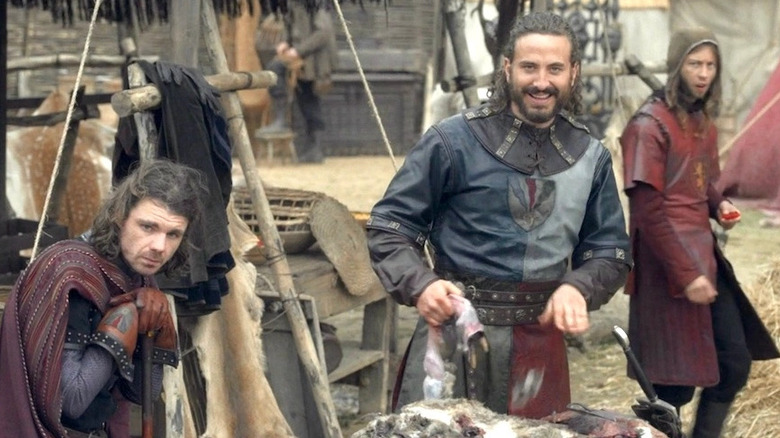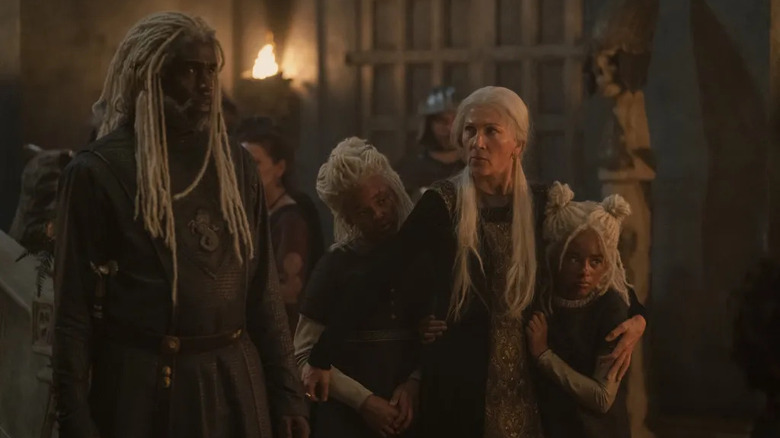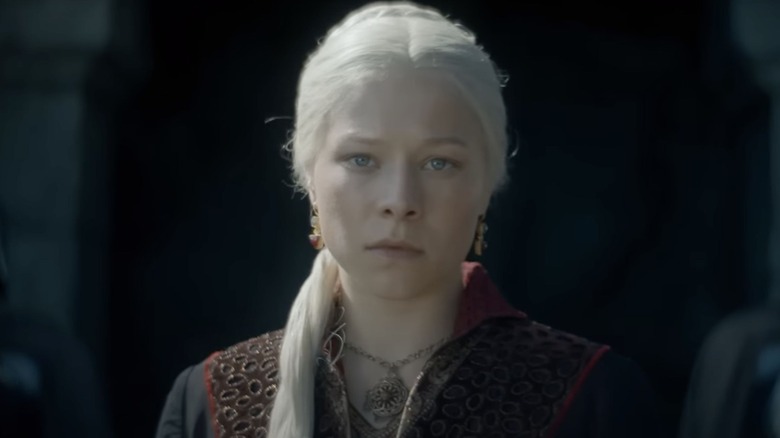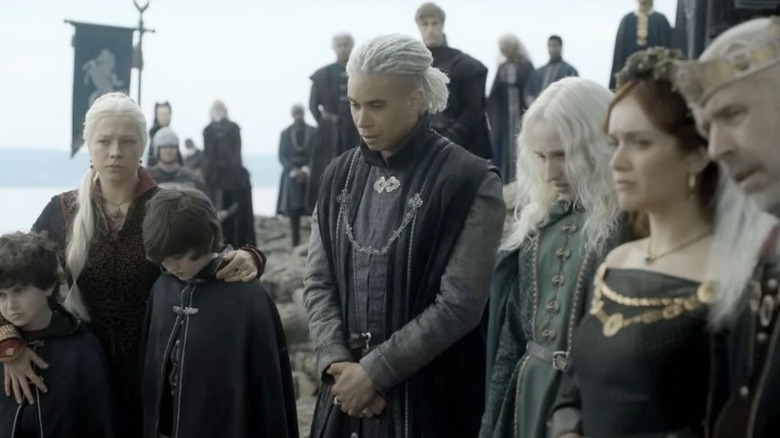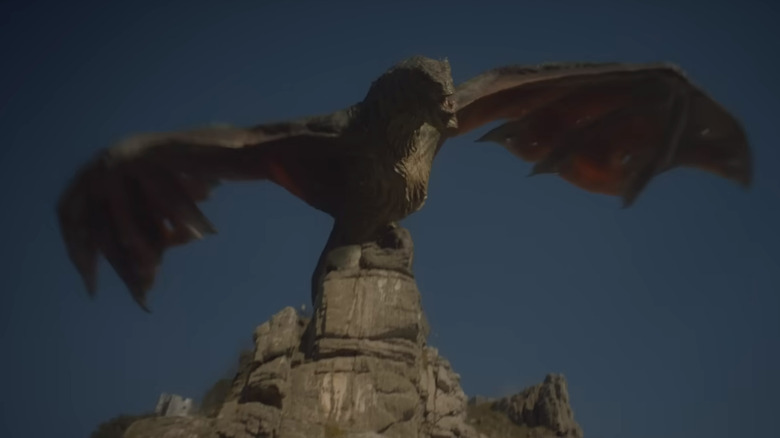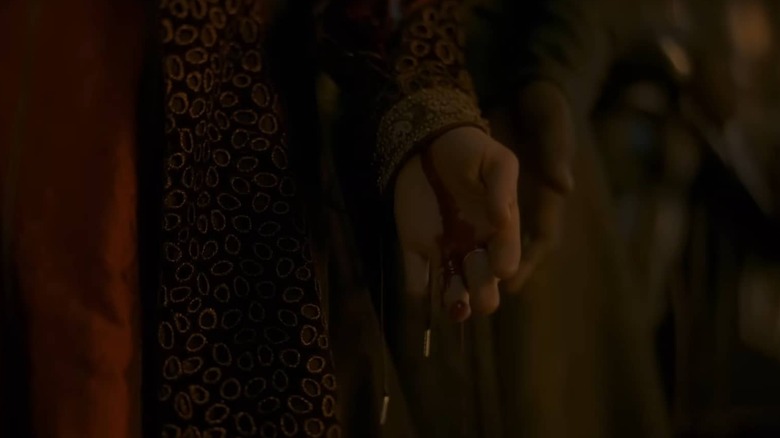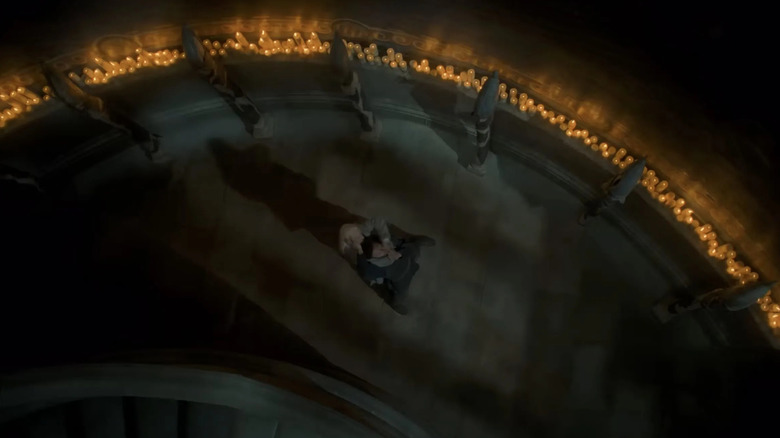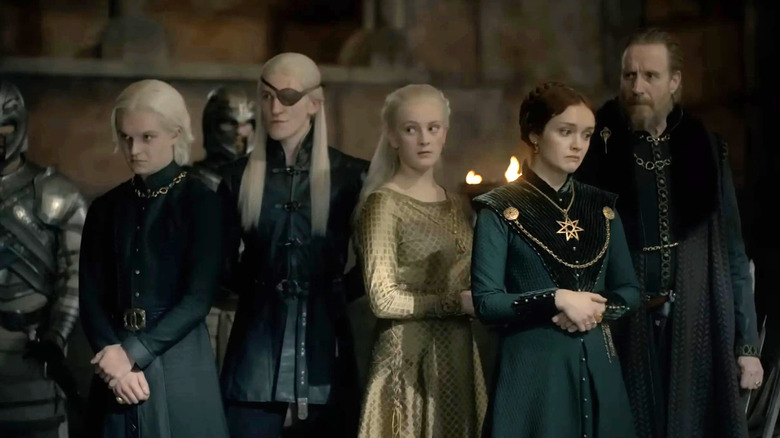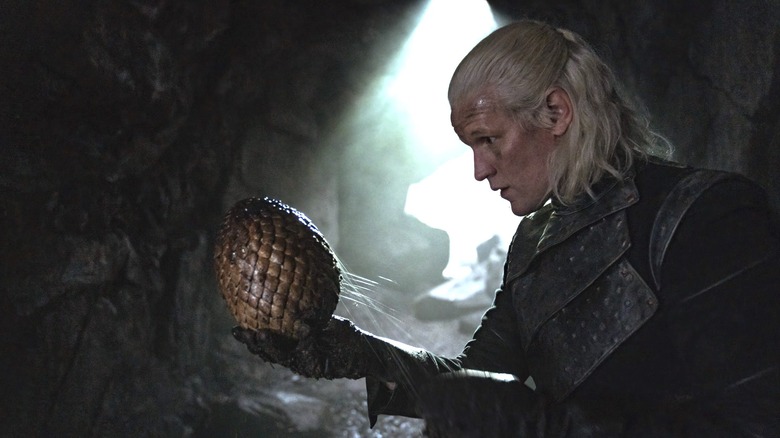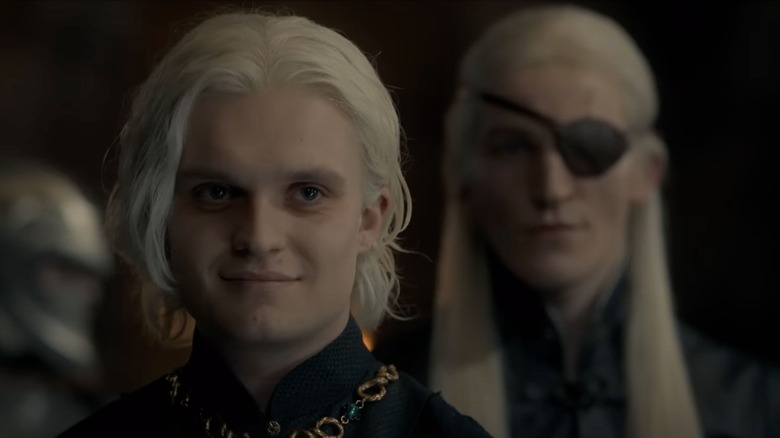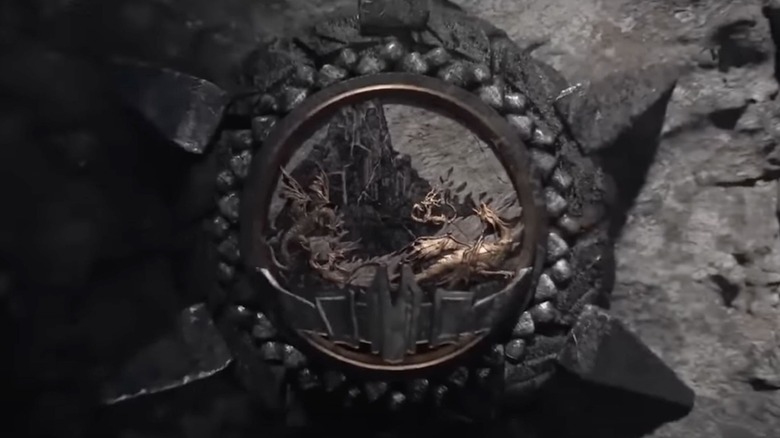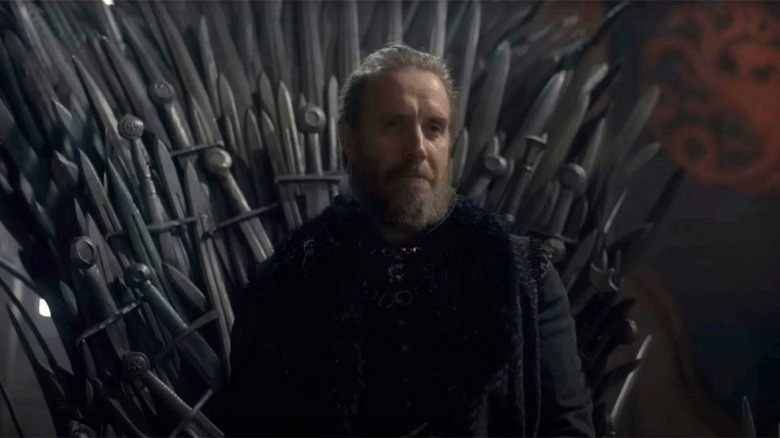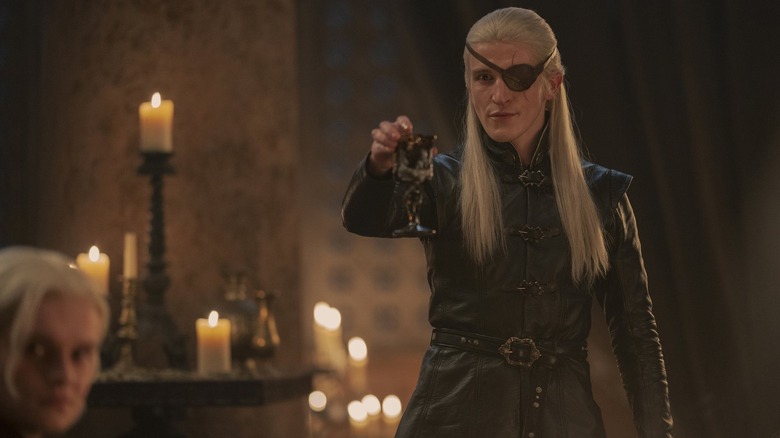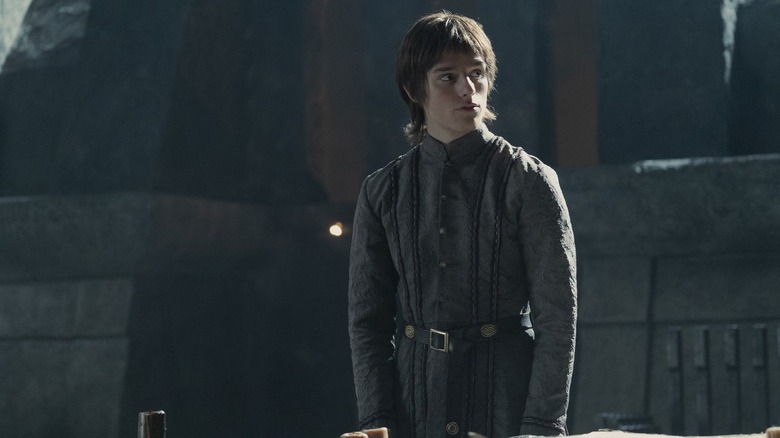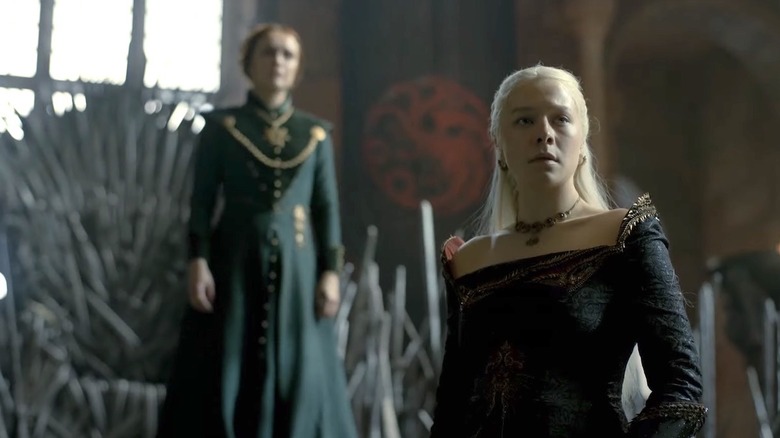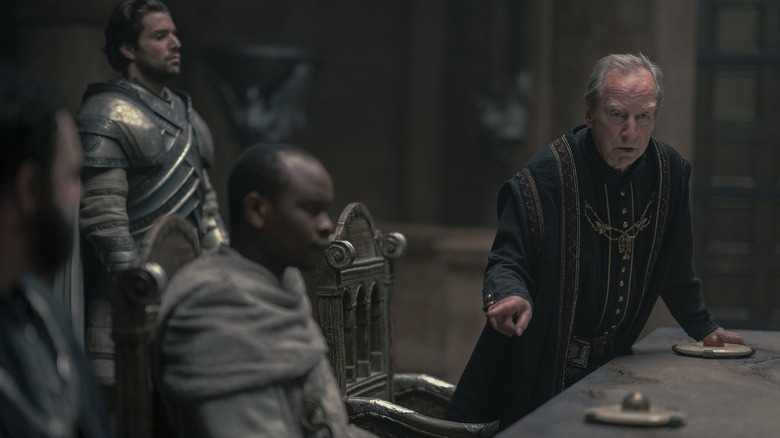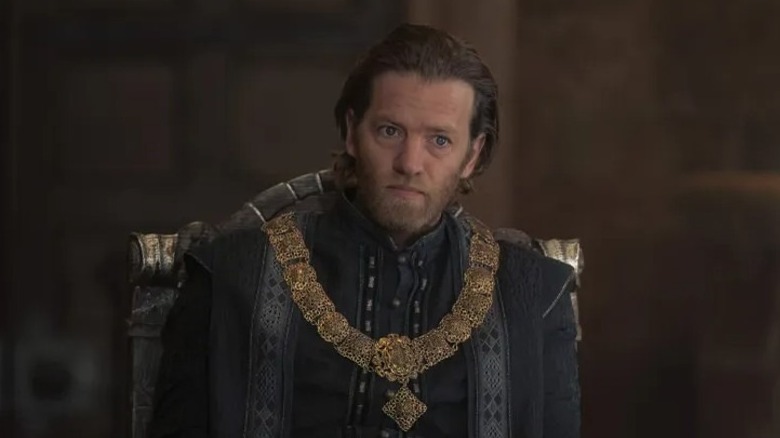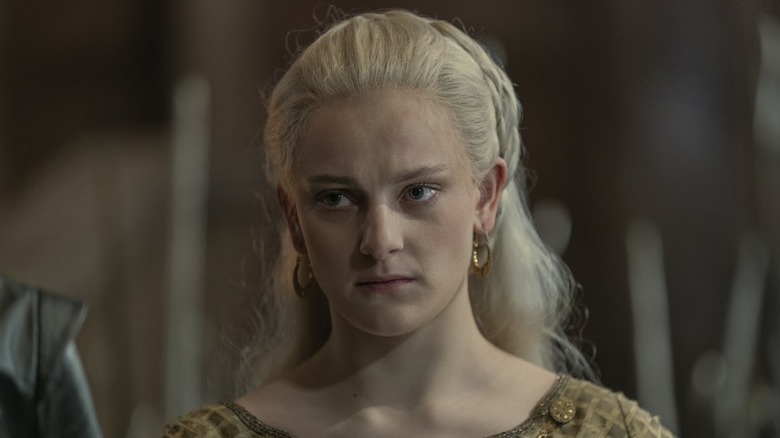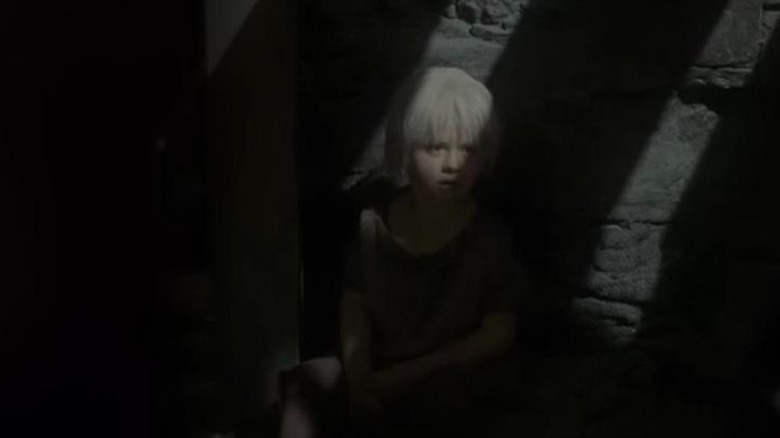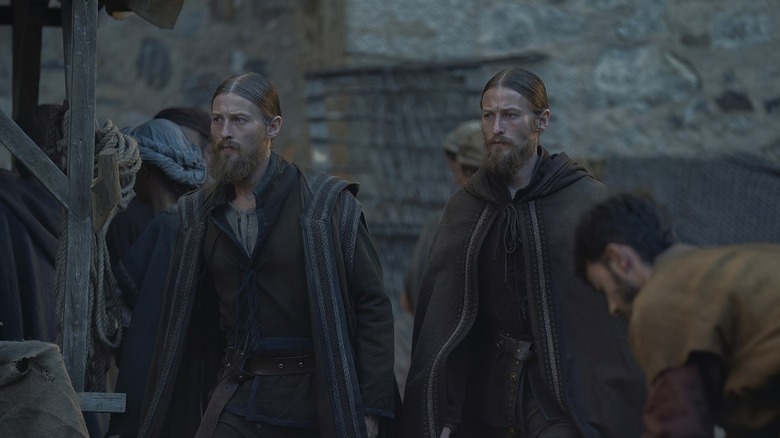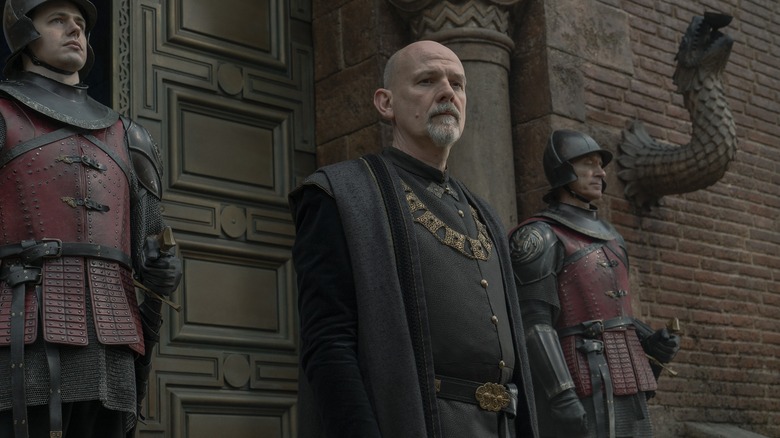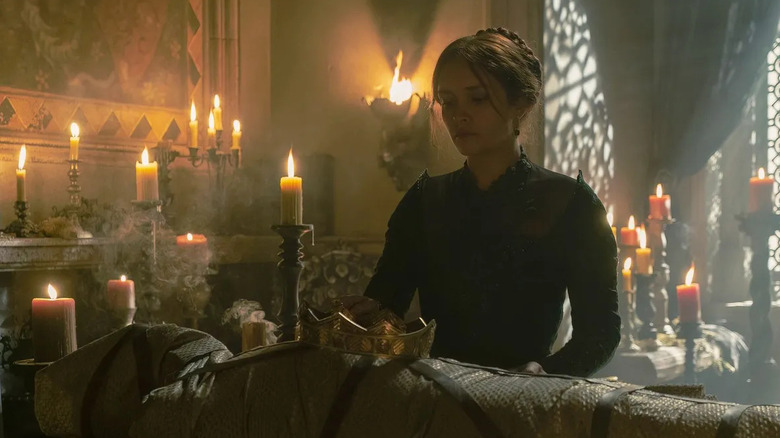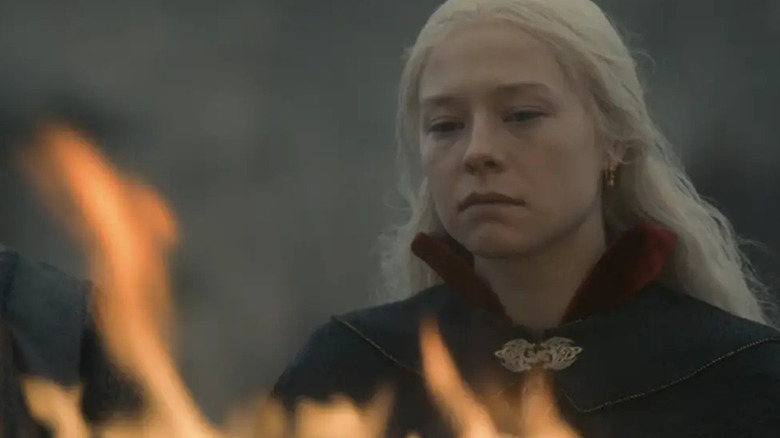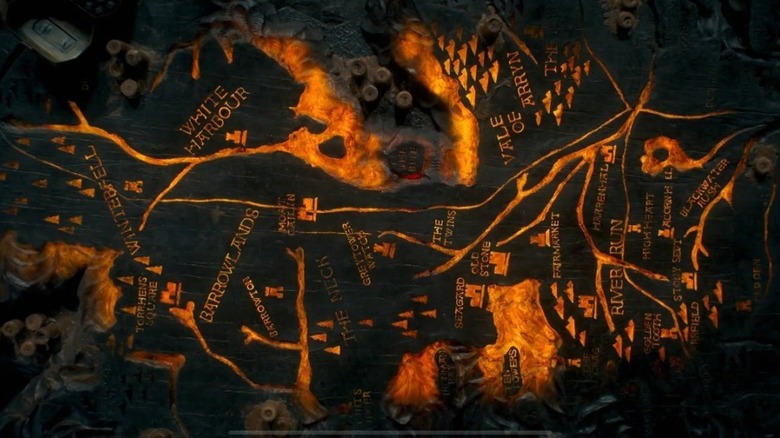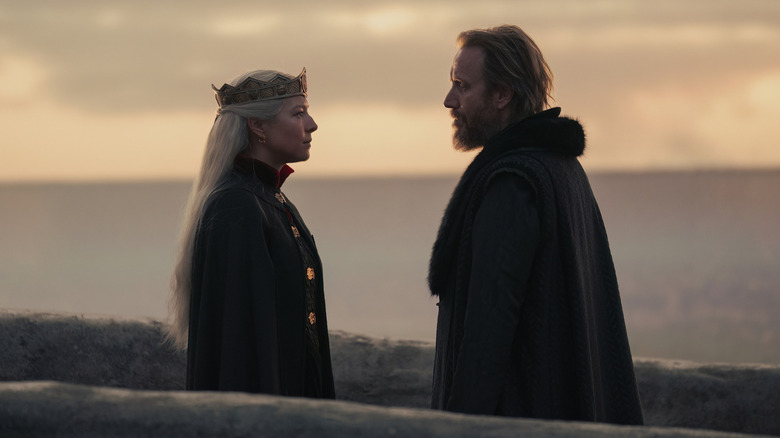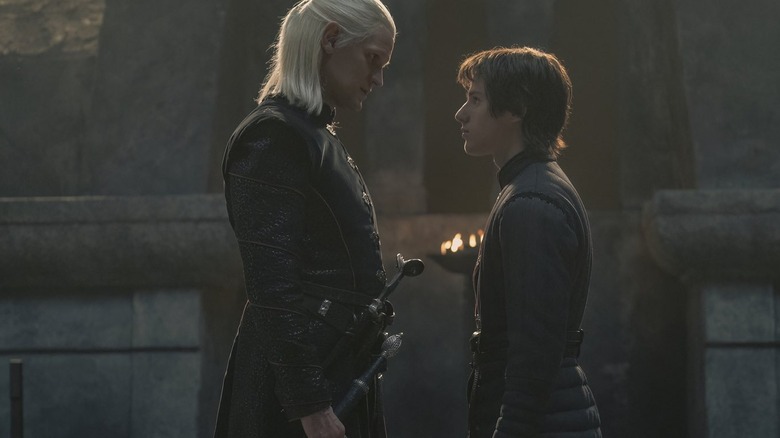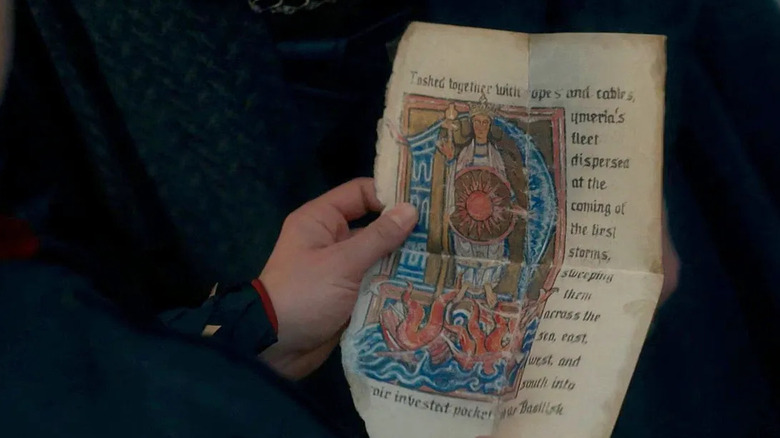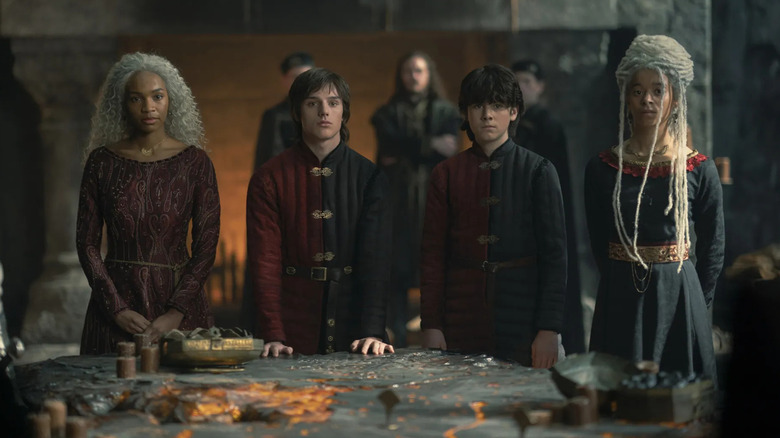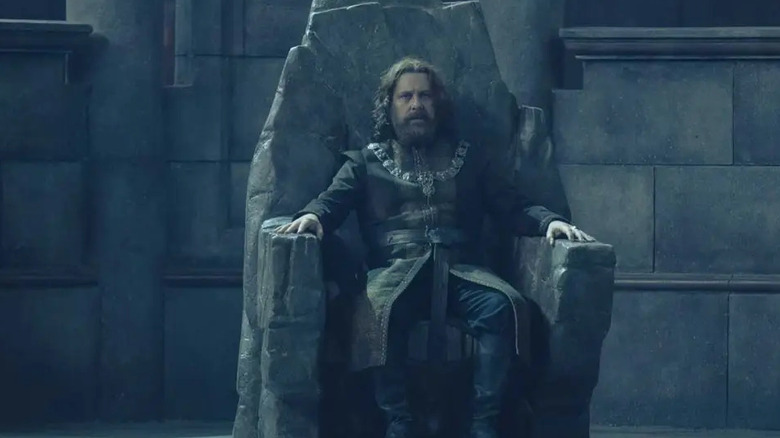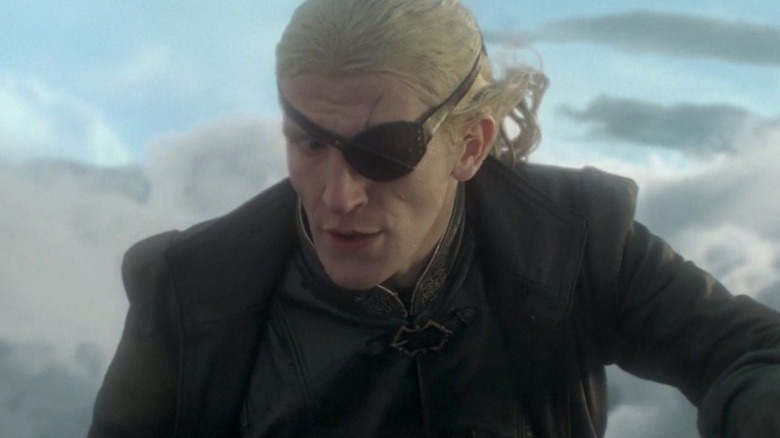Small Details You Missed In House Of The Dragon Season 1
After a final season that crept to its conclusion with its tail between its legs, HBO's "Game of Thrones" expanded universe roars back with "House of the Dragon." The prequel series, which takes place roughly 175 years before the events of its predecessor, is a mostly faithful adaptation of George R. R. Martin's 2018 book "Fire & Blood," beginning about halfway through its sweeping narrative. That volume is intended to be the first half of Martin's complete history of the Targaryens. "Fire & Blood" is written in the style of nonfiction informed by two very different witnesses to the Targaryen dynasty. Because of its dispassionate, fast-moving, and not-too-descriptive third person voice and its focus on one family, the text translates well to the small screen.
As such, the series is chock full of meaningful moments, word-for-word lines of dialogue, and dramatic details that will delight book readers. But fans of "Game of Thrones" who haven't ventured into Martin's supplemental material will still pick up on plenty of connections to the world of Daenerys Targaryen and Jon Snow. And it's propulsive and straightforward enough to be accessible even to those viewers who might be tuning in to watch a Westeros-set show for the first time. "House of the Dragon" can certainly be enjoyed for its plush design, palace intrigue, and promise of big-budget dragon battles, but Martin's lore is so dense and rich, some extra context makes following the series a more satisfying experience.
Spoilers ahead for every available episode of HBO's "House of the Dragon."
The Queen Who Never Was almost was
"House of the Dragon" begins with a crucial scene in which an ailing King Jaehaerys convenes a Great Council to determine who should inherit the Iron Throne. His own heir and a spare died during his reign and he hopes diplomacy will prevent civil war. Princess Rhaenyra, as narrator, explains the king summoned 1000 lords to Harrenhal to deliberate the claims of 14 would-be successors, only two of whom were ever seriously considered. They were Rhaenys, only child of the King's oldest son, Aemon; and Viserys, oldest son of his second-born, Baelon, who survived Aemon but not his father. Though primogeniture favored Rhaenys, the Council chose Viserys. Rhaenyra implies misogyny was to blame.
Later, Rhaenys is championed as the "Queen Who Never Was." In Martin's writing, this was her nickname, and there was a Great Council of 101, but Rhaenys never got so close to wearing the crown. In the book, it was her father's death in 92 and not Baelon's in 101 that almost saw her ascension. Aemon was Prince of Dragonstone (a title reserved for the heir). When he died in battle, the family — who'd taken to calling her "our Queen to be" — assumed Jaehaerys would appoint her Princess of Dragonstone and prepare her to rule, but Jaehaerys passed her over for his second son. Baelon's death necessitated the Council. In the source material, the lords decide between Rhaenys and Corlys Velaryon's son, Laenor, and Viserys. Viserys is favored in part because he's 24 years old, while Laenor is only seven. The series likely made the change to simplify the storyline and highlight the difficulty with which women rose to power.
The Dragonpit is intact
Part of the appeal of "House of the Dragon" is the chance to see King's Landing at a time of relative peace and prosperity. The Red Keep is brand new and the Dragonpit is in its heyday, with ten adult specimens kept within its cavernous walls. This is the same Dragonpit we see during "Game of Thrones" in utter ruin as Daenerys, Jon, and Tyrion reveal their captive wight in an attempt to convince Cersei to join their fight against the White Walkers. The Dragonpit ruins are also, symbolically, where the series finale takes place, during which a newly-formed council nominates their next ruler, putting the final nail in the coffin of the dragonriding family's domination.
That they're ruins in "Game of Thrones," however, means the Dragonpit fell into disrepair while the Targaryens still occupied the throne. Depending on how closely "House of the Dragon" hews to the books (and how many seasons it runs), we may eventually get to see its demise play out in live-action. But its existence was controversial, even at the peak of Targaryen power. Its prime hilltop location was once occupied by the Sept of Remembrance. When a religious order rose up against the crown, King Maegor I used the fire of his dragon Balerion to burn the Sept to the ground. He began construction of the Dragonpit in its place, a project that took two kings' reigns, ten years, and vast fortunes to complete. Additionally, some hypothesized that this great stable for the royal family's dragons actually stunted their growth and led to their near extinction.
A war is teased through trade route politics
Before all the gory jousting and even gorier child birthing, "House of the Dragon" gives viewers the lay of the political landscape with what seems like a tedious small council meeting ... the type that could've been an email if the series took place in the modern day real world. The King's hand, Otto Hightower, badmouths Prince Daemon for spending too much on his Gold Cloaks and failing to show up to work. Viserys just wants to party plan his upcoming tournament, during which he hopes to announce the birth of a son. And Corlys Velaryon talks trade routes, which causes everyone else to practically roll their eyes in boredom. Viewers may have caught a whiff of the "Star Wars" prequels' Trade Federation plotline.
Though it seems like a throwaway line in Episode 1, Corlys' concern will turn into a bloody affair in which power is grabbed and allegiances are formed. It so happens that Corlys is the richest man in Westeros — even wealthier than the Lannisters at the time — and the master seafarer got that way by adventuring in his ships and returning with valuable goods. He has a vested interest in those waterways and mentions the "Triarchy" at council, which refers to an alliance between the free cities of Lys, Myr, and Tyrosh. Corlys complains that their admiral, Craghas Drahar, is ridding the Stepstone islands and Narrow Sea of its bothersome pirate problem. That sounds like a good thing, but the Triarchy's oppressive tolls and even more oppressive treatment of women will pose a bigger problem than pirates ... one the show will soon address.
The Iron Throne gets a makeover
Out of all the iconography that came out of "Game of Thrones" — each house's sigil, the Hand of the King's pin, the White Walkers' swirling symbol — none was as iconic as the coveted Iron Throne itself. While most kings' and queens' seats in history and fantasy literature are grand and luxurious, the seat of power in the Seven Kingdoms was threatening-looking, and occupying it was an act of bravery in both the figurative and literal sense. That was by design. The throne wasn't meant to be a place of comfort befitting a royal; it was a reminder to all in the realm that the Targaryens ruled absolutely. They'd conquered Westeros once. If anyone challenged their supremacy, they could do it again, thanks to their belief in their own exceptionalism and their dragons. But as cold, hard, and pointy as the Iron Throne was in "Game of Thrones," it wasn't depicted as George R. R. Martin imagined.
Martin described the throne as "ugly," "asymmetric," and "huge." In his lore, it was made of the swords of 1000 enemies vanquished by Aegon I and melted by his dragon, Balerion. As impressive and intimidating as the one in "Game of Thrones" was, it wasn't a "monstrosity" that sprawled all over the throne room the way it does in "House of the Dragon." There's another detail later in the episode that speaks to Martin's world-building as well. King Viserys has a gangrenous wound on his back that he attributes to the Throne, and when we see him actually sitting in it, he cuts his hand on the armrest. There's a superstition in-world that any ruler who sheds blood on the Iron Throne is cursed.
Daemon gives Rhaenyra an expensive present
Audiences may have noticed that when Princess Rhaenyra sneaks off to meet her uncle, Prince Daemon, she asks if her father knew he was back at court. She also seems unperturbed by the sight of him on the Iron Throne (Ser Harrold Westerling is aghast!), though she goes on to tease him about his presumed place as heir. Circumstances seem to have made rivals of Rhaenyra and Daemon, but viewers may have sensed an easiness and fondness between them. That mutual affection is made more obvious by Daemon's gift to Rhaenyra: a necklace made of Valyrian steel.
The necklace is significant for two reasons. In "Fire & Blood," Daemon and Rhaenyra do have a close relationship, made so because he often brings her trinkets from his escapades. When he asks if she knows what it is, she correctly guesses that it's Valyrian steel, "like Dark Sister." When puts the chain around her neck, he tells her that now they both possess a piece of their ancestry. Later, his mistress Mysaria tries to bolster his confidence by reminding him that he wields Dark Sister and cannot be replaced. These two remarks are subtle, but viewers probably surmised that Dark Sister is his sword. What some might not know is that only two such swords remain in the Targaryen family: Dark Sister and Blackfyre. Daemon holds the former while his kingly brother holds the latter. Valyrian steel is strong, light, and stays razor-sharp (and, along with dragonglass, it's the only thing that can kill a White Walker). It's also exceedingly rare, which means this piece of jewelry is both a generous and symbolically loaded gift.
Like Arya, Rhaenyra knows her history
Rhaenyra clearly wants to lead, but she seems more interested in making her own history on the back of her dragon than she is in studying the history of those who came before her. Her companion, Alicent Hightower, implores her to recite back the story of Princess Nymeria to please the septa. At first, Rhaenyra bluffs her way through it, but when pressed, she effortlessly rattles off the bullet points. Nymeria, she says, fled her Valyrian pursuers with 10,000 ships across the Narrow Sea, arrived in Dorne, and destroyed her own fleet to "show her people they were finished running." She married Lord Mors Martell to unite Dorne under one flag for the first time.
Nymeria, and perhaps her legend, may sound familiar to fans of "Game of Thrones." Arya Stark named her direwolf Nymeria after the Warrior Queen. While few women inherited thrones on the mainland, Nymeria saw to it that lines of succession were gender-blind. After her death, her daughter ruled. That "House of the Dragon" chose to highlight the tale of Nymeria is no accident. Her strength and ambition not only mirror Rhaenyra's, her husband also mirrors one of Rhaenyra's will-be suitors. During the name day tournament, the Princess asks Ser Harrold about Ser Criston Cole, who only knows he's low-born but handy with a morning star. When Ser Criston wins and asks for the Princess' favor, he reveals himself to be Dornish, which is surprising enough to elicit a reaction from the young women.
The Gold Cloaks' brutality comes straight from the books
From the Red Wedding to the Battle of the Bastards and beyond, "Game of Thrones" was notorious for its unflinching depiction of violence. "House of the Dragon" follows suit with two brutal scenes that happen practically back to back. Before the tournament devolves into ankle axing and face smashing, Prince Daemon's Gold Cloaks try to rid King's Landing of its criminal element by using extrajudicial torture and death as a deterrent. Daemon was given the post of Commander of the City Watch upon Otto Hightower's urging as a way to keep him from meddling in more pressing royal business. Though he'd floundered in his previous roles as Master of Coin and Master of Laws, he's unexpectedly effective in his new job. Daemon professionalizes the City Watch, dubs them the Gold Cloaks, and now commands his own loyal army of 2,000 men, much to Otto's chagrin.
Daemon, who is "House of the Dragon's" charismatic anti-hero, doesn't exactly follow due process in "enforcing the crown's laws." His men are seen cutting off hands and worse. These "public spectacles of wanton brutality" weren't just dreamt up by show creators in an attempt to up the TV-MA watercooler factor, though: They're the precise punishments doled out by Daemon and his Gold Cloaks in "Fire & Blood." In the book and, it seems, the series, Daemon's brand of justice makes him popular in the way a demagogue might accumulate followers thanks to his claims that he's making the city safer.
Otto Hightower compares Daemon to Maegor
Speaking of demagogues, when Otto Hightower brings up the issue of succession at the small council following the tragic deaths of the king's wife and day-old son, he warns that the presumptive but not uncontested heir, Prince Daemon, should never sit the Iron Throne. He fears he could be "a second Maegor ... or worse." Only one episode in, it's painfully clear that the Hand of the King and the Prince are bitter rivals, so his input should be taken with a grain of salt. But to truly understand Otto's comparison, we must delve into one of the darker chapters of Targaryen family history.
Maegor I (or Maegor the Cruel) is the second son of King Aegon I (or Aegon the Conqueror) and the third Targaryen King of Westeros. He instilled fear even in his youth due to his massive size and unforgiving nature. It's believed he slew animals and even other children as a boy. In his adulthood, like Henry VIII, he went against the church and took six wives, though he didn't dissolve one marriage before taking on another. He came to power after the death of his weaker older brother, who'd tried to co-rule alongside him. He murdered his own nephew to prevent his claim to the throne. After the Red Keep was finished, Maegor had all the workers killed to preserve the secrets of its blueprints. By the end of his six tyrannical years in power, he'd managed to unite almost the entire realm against him. Daemon is an opportunistic and violent womanizer, but it remains to be seen if he can live up to Maegor's deranged awfulness.
The Heir for a Day was named after his grandfather
A major plot point in the premiere episode of "House of the Dragon" is the nightmarish birth and near-immediate death of the would-be Prince. Queen Aemma tells her daughter Rhaenyra (who has other ambitions) that the birthing bed is the woman's battlefield. She should know: She's been pregnant five times in ten years and has only managed to give birth to one daughter and a stillborn son. The battlefield analogy turns out to be more true than either of them realized. After a difficult nine months (Aemma says she's so miserable, she expects to birth an actual dragon), her baby is stuck in the breach position, and a traumatized Viserys is forced to make an impossible decision. He consents to take the child directly from his wife's uterus, knowing she will die from the blood loss. The Maester informs him the infant is a boy and asks if he and the Queen had chosen a name. Through tears of disbelief, he whispers "Baelon."
The series doesn't mention Aemon and Baelon by name (at least not in context), but Baelon the Brave, former Prince of Dragonstone and Hand of the King, was Viserys and Daemon's father. His death from appendicitis is what spawned the Great Council of 101. The baby was named after his well-liked grandfather, which makes Daemon's crude behavior even more reprehensible. The Prince threw a party at a brothel to celebrate what he perceived as the retention of his place in the succession and mocked not only his deceased nephew, but his late father.
Rhaenyra's post as cupbearer foreshadows her rise
Princess Rhaenyra is frustrated by her father's obsession with producing a male successor, and she seems ambivalent at best about her future as a wife and mother. She laments that no matter what she does, she'll never be a son, and when a son is imminent, Alicent asks her if she's worried about her position. She says no, but it's obvious the real answer is yes. So when Viserys summons her to tell her he's decided to name her his heir, she's genuinely taken aback. The King even apologizes to her for wasting many years wanting for a son when she was already worthy of the crown. Viserys warns her that the Iron Throne is the most dangerous seat in the Seven Kingdoms before he holds a ceremony to officially deem her Princess of Dragonstone, during which the lords bend the knee.
In both "Fire & Blood" and "House of the Dragon," Rhaenyra serves as cupbearer for the King's small council. This position might seem like a task that would be given to an intern, but it's actually a place of honor and a show of trust that's bestowed upon noble boys and girls. It's more explicit in the book, but by keeping Rhaenyra around him as he conducts his business, Viserys is exposing her to what's essentially classified information as well as to the daily goings-on of a monarch. A disguised Arya Stark (in another parallel to Rhaenyra) served as Tywin Lannister's cupbearer (on the show, not in the novels) because he recognized that she was high-born and he enjoyed her wit.
Balerion's skull is on display
The gigantic skull of Balerion is no small detail, but its significance and previous appearances may have been lost on some audiences. The dragon that belonged to Aegon the Conqueror, Maegor the Cruel, and finally Viserys himself, Balerion the Black Dread was the largest dragon in the post-conquest era and, as Viserys explains, the last living thing to flee Valyria before the Doom. The King asks his daughter what she sees when she looks upon his remains. Rhaenyra answers that she sees them, the Targaryens. She grasps that their family has exercised influence over the Kingdoms because they can control the fearsome beasts, but their fortunes rise and fall with the creatures to whom they've tethered their destiny. Viserys sees that they're as wonderful as they are terrible, and doubts that his people should've ever tried to tame them.
Book readers and "Game of Thrones" viewers may recognize this imposing skull, which would put any natural history museum display to shame. Among other instances, Arya happens upon it as she's wandering the cellars of the Red Keep and Cersei and Qyborn plot their attack on Daenerys' dragons from Balerion's crypt. In other words, for all the destruction that's befallen King's Landing and the Seven Kingdoms at large over the past two centuries, the remains of the Black Dread still rest in peace.
Viserys has that Valyrian steel dagger on his belt
In the final moments of the "House of the Dragon" premiere, King Viserys makes sure that his daughter, Princess Rhaenyra, understands just how precarious and loaded with responsibility her role as Queen will be. He describes Aegon the Conqueror's vision, in which a coming cataclysm will begin with a long, harsh winter and bring with it a threat from the North like the world has never seen. He tells her that for the Seven Kingdoms to survive, a Targaryen must remain on the Throne, presumably to fight the dark force with their dragons. At this point, he reveals the Valyrian steel blade at his hip.
While all Valryian steel can kill White Walkers (the threat to which King Viserys was referring), this isn't just any Valyrian steel dagger. It's the Valyrian steel dagger. A would-be catspaw assassin uses it to try to murder Bran Stark in "Game of Thrones." When he just barely fails, the weapon ends up in the Starks' possession and it follows them throughout the show. Catelyn takes it to King's Landing to try and solve the plot against her family. Its ownership, however, remains a mystery. It could've been Littlefinger's or Tyrion's; the former says he lost it to the latter in a bet. Bran eventually gives it to Arya, who famously wields it in the Battle for Winterfell to finish off the Night King, about whom Aegon's dream warned him. It's she who holds it still, as far as we know. But nearly two centuries earlier, it was the property of King Viserys I.
The crabs are feeding
Episode 2 begins with some gnarly images of sea life cleaning the flesh off the bodies of sailors who appear to washed ashore. Seconds later, a furious Corlys Velaryon bursts into a small council meeting and says something must be done about the Stepstones, the Free Cities, and the Crabfeeder. The Crown has lost four ships; one was flying his flag. Otto Hightower's solution is pay off the families of the victims and refund Corlys for his losses, but the Sea Snake doesn't think this course of action goes far enough.
In the premiere, Corlys speaks of the Triarchy and someone named Craghas Drahar. Later, when Corlys asks Daemon if he's heard about the "trouble in the Stepstones" in an attempt to recruit him into the war he wants, Daemon replies that he has heard something about some Myrish prince. Craghas, the Crabfeeder, and this prince are one and the same, as are the Triarchy and the Free Cities of Lys, Myr, and Tyrosh. Corlys pitches them as a threat to the Crown's sovereignty, but more specifically, they're a threat to his trading empire. The Crabfeeder came by his nickname honestly. Feeding sailors to the crabs might seem like a metaphor for sea warfare, but Craghas literally feeds his victims to his namesakes by fixing their bodies to stakes at low tide and letting the crabs do their thing. "Fire & Blood" leaves more to the imagination and simply explains that the name was related to the inventive punishments he inflicted upon his enemies.
The king's model room is a warning
History buff King Viserys is building (or at least commissioning) an elaborate model of Valyria, the home of the Targaryens and the other now-extinct dragonriding families. During one of their visits, he mansplains his project to the young lady who's obviously been sent to seduce him. Viserys waxes poetic about how Valyria was built into a volcano, like Dragonstone, so its people could be close to the source of their magic and power. He tells of blood mages and a civilization that was 1,000 dragons strong. Alicent asks Viserys if he thinks Westeros could be another Valryia. He answers that that depends on whether she means Valyria at its peak or at its fall.
Viserys is referring to the Doom of Valyria. Though Martin has not yet written a definitive account of exactly what happened, Valyria suffered some apocalyptic event about a dozen years after the Targaryens fled, thanks to the prophetic vision of Daenys Targaryen. Some characters speak of the Doom as if it was an unavoidable natural disaster, but the strong implication is that the Valyrians brought collapse upon themselves with their lust for said magic and power. Viserys considers his own kingdom with 10 dragons, already falling into disrepair after 100 years, and says "The glory of Old Valyria will never be seen again." Maybe not the glory, but perhaps the hubris and ruin. Viserys thinks ruling over peace means throwing feasts and tourneys, not making difficult but necessary decisions. Meanwhile, the seven hells are about to break loose. It's incredibly symbolic when he drops and breaks a dragon figurine and mistakes Alicent's ambition for kindness when she has it fixed.
Alicent takes Rhaenyra to church
Episode 2 makes it clear that Alicent Hightower is a willing participant and not just a pawn in the schemes that revolve around her (though the finger picking suggests she has mixed feelings). The main plotline revolves around Alicent and Otto's efforts to convince Rhaenyra that the king should remarry and to make sure he chooses the still-teenage Alicent over the 12-year-old Laena Velaryon, who's the better candidate on paper. To soften up her bestie, Alicent has to mediate the reconciliation between Rhaenyra and her father, who've barely spoken since her mother and brother's traumatic deaths. Step one: Alicent takes her to the Sept to pray to the Seven in an attempt to get some closure about it.
This scene is much more loaded with subtext and foreshadowing than it might seem upon first watch. The Hightowers are the lords of Oldtown, where they were once the richest and most powerful family in Westeros. They've since been supplanted by the Targaryens and Velaryons. The Faith of the Seven — the predominant religion in Westeros — also calls Oldtown home, and the two entities are closely aligned. The Hightowers support the Faith and vice versa, which increases both the noble family and the new religion's political influence. In contrast, the Targaryens have a tenuous relationship with the Seven. Publicly, they've converted, but really, they keep their ancient customs and they do their best to limit the Seven's role in Westerosi culture. By getting Rhaenyra to bend the knee in prayer, Alicent is flexing her own strength and using the religion to which she's theoretically much more devoted than Rhaenyra for cynical purposes.
Where's Vhagar?
Showrunners have promised that we'll see at least 17 dragons throughout the run of the "Game of Thrones" prequel, including at least nine in the first season. So far, we've gotten glimpses of Rhaenyra's elegant mount, Syrax, and Daemon's fierce red steed, Caraxes, also known as the Blood Wyrm. We've also heard about Balerion, the Black Dread, whose skull now rests in the cellars of the Red Keep, and Dreamfyre, whose egg was chosen for her brother, then stolen by Daemon.
On his walk with Laena Velaryon, the tween Princess asks the King what it was like to ride Balerion. Some backstory: Viserys was the last of the Targaryen kings to ride the Black Dread, and he never bonded with or rode another dragon afterwards. That means it's been quite some time since the King was on dragonback, which is itself a symbol of his supposed weakness. Then, Laena inquires about Vhagar who she says was too big for the dragonpit. Viserys retorts that she was perhaps too big for this world.
Vhagar was a female dragon, almost as large as Balerion, who was ridden by one of King Aegon's sister-wives, Visenya. Long story short, Vhagar — the biggest dragon in the world — is still out there, and no one knows for sure where she's nesting. This conversation isn't just scene filler. Vhagar is basically Chekhov's dragon, certain to show up at some critical moment in the future.
Wounds that will never heal
After King Viserys slices his finger on the Iron Throne in Episode 1, we see in Episode 2 that what started out as a small cut has rotted into a serious health situation. Though it occurs at a different point in the narrative, in "Fire & Blood," Viserys cuts his digit so badly that the bone is visible. He catches fever and almost dies before Rhaenyra's Maester intervenes and amputates. The incident scars him, physically and mentally, so much so that, in the book, King Viserys never sits on the Iron Throne again. In "House of the Dragon," the Maesters recommend maggots to eat away at the gangrene. Both versions come to the same metaphorical conclusion: the wound will not heal.
Viserys himself utters this exact phrase in another context, later in the episode. He says to Rhaenyra that her mother's "absence is a wound that will never heal," and that "without her warmth, the Red Keep will never recover." He's right. Had she lived, Viserys would've remained married to her and probably wouldn't have produced another heir. Rhaenyra's claim would be absolute, save for Daemon's insolence at being passed over. With Aemma out of the picture, King Viserys has to choose between two factions: one led by the Hightowers and one led by the Velaryons. Since neither side will ever accept the promotion of the other over their own interests, civil war is inevitable.
The rumors about Lady Johanna Swann
As Daemon, Corlys, and their forces are dealing with the Crabfeeder militarily, the landed gentry of King's Landing discuss the matter, first over a pre-journey pig roast at the castle, then in the Kingswood before the hunt as camp is assembling. The ladies of some of the Seven Kingdoms' great houses are gathered in the main tent, and when Rhaenyra joins them mid-conversation, they're gossiping about someone named Lady Johanna Swann. The women say she was abducted from one of the ships sailing through the Stepstones. When Queen Alicent wonders what will become of Lady Johanna, they say that if rumors are to be believed, she'll be sold to one of the pillow houses in the Free Cities.
To those unfamiliar with the book, this might seem like filler dialogue. However, Lady Johanna Swann is very specifically mentioned in "Fire & Blood." Hers is a story that could be spun into its own series, though Martin himself hasn't yet explored it to the extent it deserves. In the text, the people of the Seven Kingdoms become increasingly perturbed by the Triarchy's occupation of the Stepstones because the Crabfeeder isn't just stealing their goods and coin — he's human trafficking their women and children into the pleasure houses. In Lady Johanna's case, her cheap uncle the Lord of Stonehelm refused to pay their tolls, so they took his niece instead. Martin writes that, "she rose to become the celebrated courtesan known as the Black Swan, and ruler of Lys in all but name." "Fire & Blood" doesn't elaborate on that rise, as it doesn't tie back into the central Targaryen-heavy narrative.
Meet the new Master of Whisperers
Besides the Targaryens, Velaryons, and Hightowers, palace intrigue in "House of the Dragon" involves some other high-ranking families with which "Game of Thrones" fans will already be familiar — the Lannisters and the Strongs. Ser Tyland Lannister is serving as master of ships in Corlys' absence, while his twin Ser Jason Lannister occupies Casterly Rock and wants Rhaenyra's hand in marriage. Lord Lyonel Strong is currently the ruler of Harrenhal as well as the king's master of laws. His two sons, Harwin and Larys, make brief appearances in Episode 3. Larys is the young man who joins the ladies after he self-deprecatingly quips that the gods have not made him for hunting. The camera focuses on the odd boot he wears around his malformed foot.
In "Fire & Blood," Larys is sometimes referred to as Clubfoot. He walks with a limp and is regarded as a quiet man whose intentions are difficult to decipher. Larys doesn't sit with the ladies only to excuse himself from strenuous activity; he's a Varys-like character with a knack for disappearing into the background and picking up on valuable information. In the book "Game of Thrones," when Tyrion makes a saddle for a paralyzed Bran, Martin has dwarf say to the boy, "I have a tender spot in my heart for cripples and bastards and broken things." Clearly Martin does, too, as he tends to give these marginalized characters power at pivotal moments. Larys Strong plays just such a role in "House of the Dragon."
Rhaenyra has more suitors than you think
Episode 3 asks a pair of deeply related questions — will King Viserys decide to name Aegon II his heir instead of Rhaenyra, and who will the princess marry? Based on his comments to his daughter in the carriage and on the glance he exchanges with Ser Jason Lannister, Viserys seems to have made an informal agreement prior to the hunt. But, besides the fact that Jason is doing a terrible job wooing the princess and schmoozing the king, he's got competition. Viserys complains that he's drowning in marriage offers; thus far, the show has given Rhaenyra six possible suitors.
Besides Jason, who blows his chances with his treasonous assumptions, Otto Hightower suggests 2-year-old Aegon II, which even the king thinks is gross. Meanwhile, Lyonel Strong argues that Laenor Velaryon is the wisest choice. It's obvious that Rhaenyra prefers the company of Ser Criston Cole. She's creating opportunities to be alone with him, and the princess and her sworn protector openly flirt with each other. Criston even asks Rhaenyra if she wants him to kill Ser Jason. Audiences may have also picked up on some romantic tension between Rhaenyra and her uncle Daemon, and the ladies at court are aware of their mutual affection, too.
But there's one more player in the game for Rhaenyra's heart. When Lyonel Strong asks if the king wishes to hear his opinion, Viserys guesses he's about to propose his elder son, Harwin, the strongest knight in the Seven Kingdoms. Harwin is the man who caught the brown stag and the man with whom Rhaenyra exchanges her own glance as he processes its meat, and she parades bloody through the encampment.
A regal portent
Ser Otto Hightower succeeds in elevating his daughter to the position of queen, but now he's determined to elevate his grandson to the Iron Throne. Though he's close enough to Viserys to know the king hasn't altered the succession, the Hand is working every angle to get what he wants. He's scheming with the lords of powerful houses. He's pressing Queen Alicent to, in his words, lead her husband to reason. He tries to make a match between Rhaenyra and Aegon II as a failsafe. And with his counsel, he attempts to influence Viserys without overstepping boundaries.
When a white stag is spotted in the Kingswood, Otto sets the men after it and tells Viserys that the sighting is "a regal portent." Throughout the episode, he and those loyal to him and Queen Alicent push the idea that should they catch and kill the King of the Forest, it's surely a sign that the gods favor Aegon II. Tellingly, the shrewd Otto Hightower never explicitly claims that the stag's appearance means the gods want little Aegon to rule instead of Rhaenyra. He only implies as much through flattery and superstition, both of which are vulnerabilities of the king. But the animal they are tracking turns out to be a brown stag, which Viserys struggles to put out of its misery, so Otto's plan backfires. Meanwhile, Rhaenyra and Criston happen upon the white stag, whom she chooses to let live without hesitation.
Dragonriders and dreamers
Near the end of Episode 3, King Viserys promises Rhaenyra he won't supplant her and says he's only wavered once in his decision to name her heir. We get to see that crisis of conscience play out as he wonders aloud to his wife whether he made the right decision. A drunk and tired Viserys tells Alicent that there have been many dragonriding Targaryens but few dreamers among them. Viserys wasn't much of a dragonrider, but he desperately wants to be a dreamer. The king needs his vision of a son inheriting the Iron Throne to come true, not because he cares that much about a boy ruling the Kingdoms instead of a girl, but because he wants to be special like Aegon the Conqueror. He wants his dreams to mean something.
The dichotomy between dragonriders and dreamers that Viserys sets up will become thematically important as the series continues. Viserys finds comfort in the power of dreams because they represent a kind of predestination. That makes sense, as the king is indecisive to the point of cowardice during Aemma's labor and in dealing with the Stepstones. He makes a hasty and arguably poor decision in marrying Alicent. But the characters who surround him are all either actual dragonriders who happily take matters into their own hands like Rhaenyra and Daemon, or people who don't wait for signs and seize control of their own destinies like Corlys, Otto, and Alicent. Corlys advises Viserys that sailors can go around storms or through them, but they should never wait for storms to come. In a voiceover in a trailer, Daemon insists that, "Dreams didn't make us kings; dragons did." Viserys would do well to listening to these warnings.
The show's War for the Stepstones charts its own course
The War for the Stepstones takes place over a few pages in "Fire & Blood," and it's begun and resolved in one episode of "House of the Dragon." But, like the book, its effects are sure to ripple throughout the rest of the story, though precisely how might be a significant departure. In print, King Viserys approves of Daemon's private war because it's keeping him busy and away from the real business of governing at King's Landing. According to Martin, Daemon and Corlys had "little difficulty assembling an army," and "won many victories during the first two years" of the conflict with Daemon's dragon and Corlys' vast fleet of ships. Daemon easily dispatches the Crabfeeder when they meet by decapitating him with Dark Sister.
In the show, Daemon and Corlys have their backs against the wall. The rogue prince is angry when a messenger arrives with news that the king is sending backup. Though they need the help, he doesn't want it, as this was supposed to be his show of strength to contrast his reputation with that of his weak brother. In another change from the book, Laenor is also present, as is his dragon Seasmoke. But one of the most noticeable differences is the appearance of the Crabfeeder, who isn't described outside of his penchant for sex slavery and crustacean-induced torture. "House of the Dragon" has given him a severe case of greyscale, which he hides, poorly, behind a broken mask of the Sons of the Harpy, a group that opposed Daenerys' rule in "Game of Thrones." Not only has Daemon been bailed out, but he's been exposed to this disfiguring and often fatal illness.
The contest for Rhaenyra's hand turns deadly
At the end of Episode 3, Viserys tries to make amends by telling his daughter to choose a husband who makes her happy. Episode 4 starts with the tour he's arranged to introduce her to more suitors. Rhaenyra isn't interested; she dreamily fiddles with the necklace Daemon gave her and sits cozily next to Ser Criston. But at least a dozen candidates line up to state their cases, the first of whom is Lord Dondarrion. Rhaenyra remarks that he's old enough to have known her great-grandmother Queen Alysanne when she was a great beauty. The Dondarrions (from whom Beric of "Game of Thrones" hails) are loyal to the Baratheons, which might be why Boremond Baratheon admonishes her for the insult.
Next is a boy from House Blackwood. He touts his ancient bloodline and promises that, with him, her days will be easy and her nights will be safe. Of note: in the books, the Blackwoods support Rhaenys and Laenor's claim to the throne at the Great Council. Rhaenyra likes the boy's bravado, but she's not going to marry him. Another hopeful taunts young Blackwood and calls him craven, which compels the proud tween to slay his heckler by cutting him open and spilling his guts. Martin's writing alludes to a Samwell Blackwood who engaged a rival for Rhaenyra's hand in a duel, so this may be the show's dramatic reinterpretation of that sentence. In "House of the Dragon" as in "Fire & Blood," marriage is as dangerous a game as war.
Mother's favorite
In a scene that's ripped straight from the book, Daemon returns to King's Landing wearing a crown (in "Fire & Blood," Corlys performs Daemon's coronation) and calling himself King of the Narrow Sea. But he offers it up to Viserys and swears fealty, marking the full circle of their first estrangement and reconciliation. We'll see the beginning of their second estrangement by the episode's conclusion. These brothers have always had a close but complicated relationship, which comes to light during — what else — a feast the king throws in his prodigal brother's honor.
"You were always mother's favorite," Viserys says. He's in a jolly mood (made jollier by wine), but there are decades worth of sibling rivalry in his reminiscing. When Daemon protests, the king continues. He says that their mother, Princess Alyssa, "had no regard for custom, or traditional, rules," and that he, Viserys, was "no great warrior." In the source material, it's true that Alyssa favored Daemon and took him dragonriding with her from the time of his infancy. Like her granddaughter Rhaenyra, she was a hot-blooded and nontraditional woman who loved dragons, sometimes dressed in boys clothing, and preferred swordplay and taverns to more ladylike endeavors. She would've been proud of the dragonrider and fighter than Daemon became, and it's very likely that Viserys feels self-conscious about the fact that he's a Targaryen without a dragon or real combat experience.
However, in "Fire & Blood," Princess Alyssa dies in childbirth when both Viserys and Daemon would've been too young to remember much of their time with her, so their conversation is either a change from the book or the king's drunken rambling.
Alicent's in a prison of her own making
It's obvious that Alicent isn't having as grand a time at Daemon's welcome home banquet as she was during the hunt. She steals a moment alone with Rhaenyra, in part to convince her to marry and in part because she's lonely. Their girl talk has the opposite effect, however. Rhaenyra snipes back, "How romantic it must be to get imprisoned in a castle and squeeze out heirs." At first, she seems unaware that she's just described her former best friend's situation. A sheepish Alicent then confesses, "I find I have few friends lately," before the Princess admits she misses her, too.
The middle part of the episode flashes back and forth between Alicent and Rhaenyra's very different nights. "Who knows when I'll next taste freedom?" the latter says as she's running through the streets (and bumping into a discreet Harwin Strong). Meanwhile, the queen is trying to calm her crying infant as she stares out from behind a barred window. It's intentionally meant to look like a gilded jail cell. Moments later, Daemon, in his seduction of his niece, explains that "marriage is duty," but that it doesn't have to stop them from doing what they want. At the same time, Alicent is called to her husband's bedchamber for sex. She lies there emotionless, unable to refuse her king. Alicent has attained the highest position available to her, but — especially as a pious noblewoman and mother — she has no say in how she spends her days. It's one endless slog of attending to babies, attending to an ailing older man, and always being on her best behavior.
Here is where our sources diverge
The events of the fourth episode are a turning point in "Fire & Blood," but Martin's narrator explains when it comes to Rhaenyra and Daemon, the book's sources diverge. According to Septon Eustace, the Princess had an enormous crush on her uncle and was easily seduced. When a guard caught them, Rhaenyra told the King she was in love with his brother and begged to marry him, which the king forbade as Daemon already had a wife.
Mushroom's version is "more depraved." He claimed Daemon took Rhaenyra to the pleasure houses and fooled around with her (but did not deflower her) so that she could learn how to be good in bed for Ser Criston, whom she hoped to lose her virginity to. It's unlikely she ever would've married Ser Criston; he was common, and had sworn vows to the Kingsguard. But as Daemon says to Rhaenyra in the show, such things needn't stop her from doing what she wants.
"House of the Dragon" blends the two accounts. Daemon does sneak Rhaenyra out in pages' clothing, as he does in the book, and he does take her to the Street of Silk. It's unclear what happens between them, physically. The Princess does, however, use her newfound carnal knowledge to bed her White Knight. But when Rhaenyra and Daemon are accused, they tell different stories: She assures Alicent that her virtue is intact (at least regarding Daemon) while he doesn't deny anything. In keeping with the spirit of the book, Viserys tells his daughter that the truth doesn't matter, only perception, which is a shrewd way to read history, including the fictional history of Westeros.
The White Worm whispers
A door creaks just as Rhaenyra and Ser Criston are in the throes of passion. For a moment, the audience thinks they've been caught, but it's a purposefully misleading edit. Otto Hightower practically rushes into the king's bedchamber at the crack of dawn with "discomforting news." He tells Viserys that Rhaenyra was spied the pleasure house with Daemon, coupling, as he puts it. Viserys finally has the sense to question Otto's motives and loyalty to the Crown, but the Hand insists this source has yet to lead him astray. That source is the White Worm, who uses a boy spy and messenger to practice her trade, and the White Worm is revealed to be Mysaria when that same boy comes to her later for payment.
Since what exactly happened at the pleasure house is still a mystery, we can't be sure if Mysaria's spy actually saw what he reported or if she's now in cahoots with Otto Hightower after what Daemon put her through on Dragonstone. After all, the spy followed Rhaenyra as she ran after Daemon, not as they were in the act. Ironically, Daemon is with Mysaria when she pays the boy. She says she's gotten out of the skin trade, since it could only take her so far. Daemon thinks this means she's making money from boarders. He doesn't know that she's actually gotten into the business of selling secrets — or does he? It's also possible she's still on his side, since getting caught might've been Daemon's plan all along. If he marries Rhaenyra, as he proposes once Viserys thinks he's "defiled" her, he'll be closer to the throne than he ever could be otherwise.
Rhaenyra's fate is written on the catspaw dagger
Regardless of "whatever transpired" as he puts it, Viserys decides to move forward with Rhaenyra as his heir, and he decides to force her to move forward with a politically advantageous marriage to Laenor Velaryon. But it's not just the current divisions within the kingdom that worry the king. He puts stock in dreams, and none more so than Aegon's. Viserys holds the catspaw dagger to a flame and tells his daughter that dagger belonged to Aegon the Conqueror, saying that "pyromancers hid his song in the steel." Rhaenyra picks it up and reads the blade's inscription: "From my blood, come the Prince that was Promised, and his will be the song of ice and fire."
Viserys whispers, "Responsibility I have handed to you," which he reminds her is larger than herself or her desires. The word has two meanings. Viserys has entrusted her with the knowledge of Aegon's dream. She knows that some threat lies in wait in the North. But he also means that it may be her responsibility to give birth to the Prince that was Promised, or to continue a family line from which that prince will come. When Rhaenyra complains that if she'd been born male she could sleep with whoever she wanted and sire any number of bastards, Viserys agrees. Her father the king needs her not just to marry for peace in their own time, but to produce a strong, Valyrian, dragonriding heir who could be the savior of the world. When the Maester leaves Rhaenyra the abortifacient tea, it's not just an implication that he's not sure whether to believe her. He wants to preserve her womb for the foretold Prince.
Lady Rhea Royce's bronze armor
Throughout "Fire & Blood" and "House of the Dragon," Prince Daemon Targaryen calls his wife, Lady Rhea Royce, his "Bronze b*tch." The meaning of the second part of that regrettable pet name is clear to audiences. Daemon and Rhea's marriage isn't a happy one, to say the least. It's not even much of a marriage; we find out in Episode 5 they are yet to consummate their union and Daemon spends little to no time in his wife's homeland, the Vale. The meaning of the first word, though, might've been less clear.
Bronze doesn't refer to Rhea's skin or hair color — it's an allusion to her family crest and her people's royal lineage. House Royce can trace its roots all the way back to the First Men; they ruled as "Bronze Kings" until House Arryn assumed power during the Andal Invasion. House Royce became loyal vassals of the Arryns and remained in their seat at Runestone, which Rhea and her potential offspring stood to inherit. Their flag is a bronze square framed by ancient runes, and they wear bronze armor, as does Rhea when she goes hunting in Episode 5. Daemon's insult is meant to demean her and her house's standing.
Why Daemon dislikes her so is left to the reader's imagination, as are the circumstances of her death. In Martin's writing, she dies nine days after hitting her head against a stone when she's thrown from her horse during a falconry hunt. Here, Daemon causes her horse to rear up and finishes the job with a stone after she mocks him for his impotence (which is becoming a running theme when it comes to the Rogue Prince).
Ser Criston fears the traditional punishment
Ser Criston Cole might've admitted to dalliances in his youth, but that was before he recorded his name in the White Book of the Kingsguard and swore a vow of chastity. Whether he actually has strong feelings for Rhaenyra or is merely more pious and rule-following than he let on, the Princess's White Knight is desperate to absolve himself of his sin someway, somehow. First, he asks Rhaenyra to run away with him rather than marry Laenor Velaryon, as she's been commanded to do. When she suggests that he should be happy enough as her lover and sworn protector, essentially asking him to commit what he sees as sin over and over again, he's disgusted by the idea, and his feeling and loyalties undergo a drastic change.
That swing is made even more pronounced when Queen Alicent summons him. He reveals the truth and asks her to give him the death penalty rather than sentence him to gelding and torture. Ser Criston was right to worry; the Kingsguard is a lifetime appointment, and punishment for those who break their vows is castration, followed by a lifetime sentence at the wall. That's what happened to Ser Lucamore Strong, who served in King Jaehaerys's service, in relatively recent Westeros history. He secretly took three wives and fathered many children, and when he was discovered, "Lucamore the Lusty" was gelded and sent to the Night's Watch. That chaste and religious Alicent shows Criston such mercy, both during his questioning and in his moment of hopelessness when he nearly takes his own life, will have made a strong impression.
The King's condition worsens
King Viserys is looking worse for the wear with each passing week. What started out as a single (but still pretty concerning) seeping wound has turned into a host of various infections and afflictions. Actor Paddy Considine commented that, for the show's purposes, Viserys is suffering from a form of leprosy (let's hope for Queen Alicent's sake it's non-communicable). Eagle-eyed viewers could've seen in previous episodes that the king had lost the fingers that turned gangrenous after he sliced them on the throne, but in Episode 5, his cousin Rhaenys notices too. Otto Hightower is even more acutely aware of the situation; he assures his daughter that her husband will not live to be an old man.
In the book, Viserys brings most of his medical problems on himself because of his vices (too much fondness for food and drink, as well as a lack of physical exertion). However, "Fire & Blood" and "House of the Dragon" do have something in common when it comes to the king's failing health. On several occasions in the show, a younger Maester has attempted to either improve the king's condition or relieve his suffering. Most of the time, the more senior Maester Mellos rejects that advice, as he does when he uses leeches instead of the purple poultice on his Majesty's arm. In "Fire & Blood," the post of Grand Maester is of great political importance. Rhaenyra insists he follow the treatment of her choice, Maester Gerardys, while Alicent wants him to rely upon Hightower's Maester Alfador. The larger point in both versions, however, is that the king's rapid decline could've been prevented or alleviated with the right Maester in charge.
Meet Meleys
As a Targaryen without a dragon, King Viserys is something of an outlier. So far, we've seen Daemon on Caraxes, Rhaenyra on Syrax, and Laenor (who's half Targaryen and all Valerian) on Seasmoke. We also know that Laena is a big fan of the creatures, even though she hasn't tamed one as of yet. But Princess Rhaenys is the most senior Targaryen with the most dragonriding experience, and in Episode 5, we finally get to see her mounted on her dragon, Meleys.
Rhaenys may be called the Queen Who Never Was, but her dragon is known as the Red Queen, so named for the beautiful rosy tint of her wings and scales. She's faster than Caraxes, and will be one of the fiercest and most important non-human characters going forward in "House of the Dragon." Meleys originally belonged to Viserys and Daemon's mother, Queen Alyssa, and both then-princes took their first dragon rides upon her back when they were only days old. When Alyssa died in childbirth during the boys' youth, Princess Rhaenys bonded with Meleys. The young princess toured the Seven Kingdoms with her grandfather, King Jaehaerys, and she rode the Red Queen to her own wedding with Corlys when she was only about 16 years old. It's a nice touch that the show has her riding alongside Laenor en route to her son's nuptials.
A Mushroom sighting?
As previously mentioned, "Fire & Blood" is a fictional collected history compiled from different sources who were privy to different events in different ways, and who each had their own political point of view and allegiances. The narrator whose accounts are often the most detailed and scandalous is Mushroom, a dwarf who served as fool to King Viserys' court. His physical appearance and position (he was three feet tall with an oversized head) led many in the nobility to assume that he was intellectually disabled. Because of this, it's been speculated that perhaps people let their guard down and spilled their secrets in front of the "lackwit" (who was, in truth, savvy and observant), which would've allowed him to provide the most accurate history of the time leading up to the Dance of the Dragons and of the Dance itself in "The Testimony of Mushroom."
Fans of "Fire & Blood" have had their fingers crossed that we might get to see Mushroom as a character in "House of the Dragon." No announcements to that effect have been made and an actor does not appear to have been cast in the role; however, there is a background character who fits Mushroom's description during the beginning of Rhaenyra and Laenor's wedding festivities. He's wearing Targaryen colors and playing music with the rest of a band, which is close enough to a court jester. He's even featured in the teaser for Episode 5. This is probably just a wink to book readers, but our mystery man could come back to record his story. It's worth mentioning that Mushroom was quite fond of Rhaenyra, and thus his version would be inclined to put her in a more favorable light.
A show-stopping green dress
The costuming on "House of the Dragon" isn't commendable just for its stunning design and impeccable construction. The attire worn by King's Landing's movers and shakers is significant and symbolic in Martin's writing, and so far, the show is doing a phenomenal job of illustrating that. The single most consequential piece of clothing — with literal life and death consequences — is Alicent's green dress, which makes its debut in Episode 5. She interrupts her husband's wedding toast (which Harwin Strong rightly points out will upset the king) and catwalks through the throne room in an exquisite emerald green gown, pulling all the attention away from the reigning monarch and the heir and bride to be.
Larys Strong asks his brother if he remembers what color House Hightower uses in its beacon to call its people to war. The answer is green. That means with this dress, Alicent is effectively using fashion to fire the first shot in the coming Targaryen civil war. It's her official proclamation that she does, in fact, want her son, Aegon II, to be King. The occasion for which she wears the dress is a change from the book. In "Fire & Blood," it's at her own fifth wedding anniversary party with Viserys that she unveils her new look. When, in coming episodes, characters begin to align themselves with "the Greens," it's this gown that gives their side its name.
Smell a rat?
For several weeks in a row, various rodents have scurried in and out of frame on "House of the Dragon." There was one on a bedpost in Episode 4. In Episode 6, Viserys spots a mouse on a mantle as he's alone in his bedchamber while Larys performs his monologue about the weakness of children to Queen Alicent. But the most overt inclusion of a rat is the one that drinks the recently deceased Ser Joffrey Lonmouth's blood as Rhaenyra and Laenor exchange their vows.
Book readers felt smug about this reference, which is a not-very-coy indicator of a coming plotline that involves two characters who go by the names Blood and Cheese. What Blood and Cheese get up to exactly is a huge spoiler, so we'll say no more about them here. There's also a ship named Mouse that factors into the Dance of the Dragons much later on. Still, King's Landing's prominent vermin problem might have another decidedly non-metaphorical explanation. Though there's no textual evidence of this theory in Martin's writing, Reddit moderator and YouTuber Joe Magician has laid out the possibility that a character on "House of the Dragon" could be a greenseer like Bran Stark. If so, the mice and rats (as well as the weirwoods, where conversations frequently take place) could be used to spy and gather information.
Loyal Lord Caswell
Ten years on, literally every move mortal enemies Princess Rhaenyra and Queen Alicent make is a power play. Episode 6 opens with Rhaenyra's delivery of her third child. Just about the moment the midwife places the babe in the princess' arms, a messenger arrives to take the newborn to the queen's chambers. Rhaenyra will not have her son separated from her so quickly. Before she's even passed the placenta, she dresses to make the long walk through the Red Keep. Her husband, Laenor Velaryon, accompanies her and holds her upright as she has to stop each time she has an afterbirth contraction.
During one of these moments on a staircase, Lord Caswell of Bitterbridge and his lady wife approach Rhaenyra and Laenor enthusiastically. He tells her what a privilege it is to be among the first to congratulate her on the birth of the baby, then offers, "If I may be of any service," before Rhaenyra cuts him off. "The day may yet come, my lord," she says, mostly as a pleasantry to excuse herself, as she's clearly in pain and struggling to say standing. But she's also publicly recognizing that he's in her corner, despite her condition. This is a subtle bit of foreshadowing on the show's part. In "Fire & Blood," House Caswell remains staunchly loyal to Rhaenyra and the Blacks as tension and uncertainty about the succession mount. If "House of the Dragon" remains similarly faithful to the source material, that loyalty will soon be tested in dramatic fashion.
An unusual name for a Velaryon
After Rhaenyra wills herself to the queen's private quarters, she presents the newborn prince to Alicent, who's basically become her evil stepmother, and her father King Viserys, who's shockingly still alive (though just barely). Viserys is genuinely happy to meet the child and remarks that he thinks the boy has his father's nose. When the queen asks what they'll call him, Rhaenyra begins to say they haven't decided, but Laenor bursts out with the name Joffrey. Alicent quips, "That's an unusual name for a Velaryon."
With this polite-enough sounding comment, Alicent is actually making two accusations. Though we only met him briefly, Joffrey was the first name of Laenor's lover — Ser Joffrey Lonmouth, the Knight of Kisses — who was brutally murdered by Ser Criston Cole at the welcome feast in Episode 5. Laenor and Joffrey's relationship was an open secret, at least at Driftmark and probably even at King's Landing; still, for the queen to underscore the fact that the future king consort wants to name his purported son after his stricken-down boyfriend is remarkably bold. Alicent is also implying that she knows this child, like the previous two, isn't really Laenor's, since she's well aware of his sexual preferences. She follows up her jab about his choice of a name with the advice, "Do keep trying, Ser Laenor. Sooner or later, you may get one who looks like you."
A divided small council
King Viserys' small council has changed considerably over the years. Corlys Velaryon has been replaced by Tyland Lannister as Master of Ships. When Otto Hightower was dismissed as Hand of the King, Lyonel Strong was chosen to fulfill that most important role. Only Lyman Beesbury remains in his original position of Master of Coin. But two of the most noticeable changes to the king's council are the addition of his daughter, Princess Rhaenyra, and his wife, Queen Alicent. Rhaenyra was promoted from cupbearer to council member after being named heir and Princess of Dragonstone. A decade later, a much more politically active Alicent also has a seat at the table.
Production designers conceived of small spheres to signify a character's presence at the small council table, each either made of or painted in colors that represent the great houses to which the council members belong. Queen Alicent sits behind an emerald green ball that's reminiscent of Hightower's colors and her infamous gown, while Rhaenyra rolls her fingers across an onyx black one for House Targaryen (we've yet to see her black dress). These totems mean that not only have both women staked their claims as the leaders of the Greens and the Blacks, but they also demonstrate that both have accumulated immense power in the last decade, regardless of their opposition to each other. Earlier in the season, it was frowned upon for the princess to speak at all when she's with the lords behind the closed doors of the small council room. Now, she and Alicent are practically running the show, though they disagree about everything.
Daemon the Merciful?
In "Fire & Blood," Prince Daemon Targaryen is implicated in all sorts of scandals and crimes, but readers rarely get confirmation that he's done wrong. "House of the Dragon" has shown the Rogue Prince stealing a dragon egg, corrupting his niece, and killing his wife. But he's just so charismatic, it's hard to root against him, even if the audience knows for sure he's an indefensibly terrible person. This week, however, Daemon shows us that he's capable of good, or at least more good than his brother, Viserys, or the average Westerosi husband and father.
During the show's 10-year time jump, Daemon and Laena have married and are raising twin daughters, Baela and Rhaena, as upper-class nomads on dragonback. He rides Caraxes. Laena has since tamed the object of her affection, Vhagar, the largest remaining dragon in the world. She's pregnant with their third child and goes into labor while they're visiting Pentos. After hours of pushing to no avail, Daemon is given the choice to cut open his wife to save the child. He asks if the mother will live. When he's told no, he doesn't appear to consent to the procedure, which allows Laena to live out her final moments with dignity and as she wishes. In a heartbreaking scene, Laena crawls before Vhagar and repeatedly screams "Dracarys" until the reluctant dragon burns her alive. In the book, the baby — a son — dies an hour after its birth and Laena follows shortly thereafter, though it's thought she attempted to ride Vhagar one last time.
Larys, Lord Confessor
We met Lyonel Strong's sons, Harwin and Larys (also known as Breakbones and Clubfoot) during the hunt in Episode 3. Larys has since ingratiated himself to Queen Alicent by becoming her unofficial Master of Whisperers while Harwin has entangled himself in some deadly serious palace drama by fathering Rhaenyra's three children. Savvy viewers will have noticed that Harwin — who was commander of the Gold Cloaks — was quite taken with Rhaenyra after she killed the boar and when she donned boys clothing on the Streets of Silk. He's also the one who carries her to safety after the melee at the welcome feast.
Larys doesn't seem to have a very high opinion of his father, the Hand, or his brother. When Queen Alicent complains that King Viserys wouldn't accept Lyonel's resignation after Harwin attacks Ser Criston in the training yard, Larys graduates from whispers to actions. Lyonel takes Harwin to the family seat of Harrenhal, which is said to be cursed, to avoid persistent rumors of the princes' parentage. Meanwhile, Larys frees some of King's Landing's most dangerous prisoners, so long as they're okay with him cutting off their tongues so they can't spill his beans. He sends his assassins to Harrenhal to murder his father and brother via arson, which he tells a horrified Alicent that she'll thank him for later, as he holds the foreign flower to which he previously compared her.
In "Fire & Blood," Larys isn't just Master of Whisperers; he's Lord Confessor. That title is a euphemism for torturer-in-chief, so it's no surprise to book readers that he's so psychopathic and eager to break out the tools of his trade.
The thinning Velaryon bloodline
Episode 7 opens with Laena's funeral. She may have died a Targaryen death in Pentos when she commanded Vhagar to incinerate her, but on Driftmark, she's receiving a proper Velaryon sea burial. Her uncle Vaemond delivers a eulogy at the end of which he says that Velaryon blood must not thin. Daemon, who has just lost his wife, chuckles uncomfortably at this. Likely, his outburst is at the farce that has become the question of Rhaenyra's children's parentage. Moments later, Corlys — who, it turns out, is as committed to keeping up appearances as Viserys — tells second-born son Lucerys that someday he'll inherit this castle. Little Luc is distraught by the idea ... should he become Lord of Driftmark, it would mean that everyone else is dead. And that, precisely, is the other hidden message in Daemon's inappropriate laughter.
Rhaenys, on the other hand, is a pragmatic player in the game of thrones and asks Corlys to use the occasion of Laena's wake to name Baela princess of and heir to Driftmark instead of Lucerys. She knows the three princes aren't really their kin, but the twin girls are, and she wants their domain to remain in the true family line. Corlys argues that history remembers names, not blood. By the end of the episode, as far as everyone is aware, the Velaryon family tree will have been pruned even thinner. Laenor seems to have lost a duel with his patron Qarl and has been disposed of in the fireplace. Baela and Rhaena remain, but as girls, they don't carry the Velaryon last name. Jacaerys, Lucerys, and Joffrey have the name but not the blood, and Corlys' legacy is in jeopardy.
Rhaenyra in Black
Episode 5 marks the first appearance of Alicent's green dress that serves as a call-to-arms. Book readers will know that the two factions who end up at war with each other come to be known as the Greens and the Blacks. Rhaenyra even calls Alicent and her supporters "the Greens" for the first time this week as she discusses the precariousness of her current position with Daemon. That, combined with the fact that we finally see the princess of Dragonstone in Black, means this familial civil war has truly reached the point of no return.
Prior to Episode 7, Rhaenyra was usually costumed in some combination of creamy white, gold, and red. These colors are meant to symbolize if not quite her innocence, then at least her youth or perhaps her optimism. The Targaryen colors are red and black, but on their traditional sigil, black is more prominent. The fact that she's attending her friend's funeral (in the book, Rhaenyra and Laena are very close over a long period of time, and the princess is even with her sister-in-law at the time of her death) gives her a reason to change into a darker color scheme, but this is also the installment in which Rhaenyra and Alicent themselves come to blows. It's also notable who else is wearing black: The King, Daemon, Corlys, Rhaenys, Laenor, Jacaerys, and Lucerys. Alicent and her three children are still cloaked in a darker shade of Hightower green, even at these somber proceedings.
Four weddings and a funeral?
"Driftmark" begins with Laena's funeral and ends with Rhaenyra and Daemon's wedding, but three more betrothals are either referenced or subtly teased throughout the episode. Aegon scoffs at having to marry his "idiot" sister, Helaena, who's muttering to herself about the Blacks, the Greens, and the coming Dance of the Dragons as she tries to trap a spider. If it wasn't clear last week, it is this week — Helaena is a dreamer with the ability to foretell the future, though we're not sure if she's aware of her own power yet. In the previous episode, she said Aemond would have to "close an eye" to get a dragon, which comes to pass. That Aegon and Helaena are to wed means Alicent got her way and refused Rhaenyra's proposed match with Jacaerys, which had pleased the king. Viewers can probably guess based on Prince Aegon's attitude toward his sister alone that theirs won't be a happy marriage.
This also means Jacaerys is free to marry someone else. His mother tells him to comfort his cousins, Baela and Rhaena. The best the young boy — who's mourning the loss of his own father, Harwin Strong — can do is stand next to them. Baela grabs his hand in solidarity. Later, when Aemond steals Vhagar, it's Lucerys who defends Rhaena — whose egg is yet to hatch and who wanted to claim Vhagar — against his half-brother. In "Fire & Blood," Rhaenyra and Daemon intend to wed Jacaerys to Baela and Lucerys to Rhaena. These new marriage arrangements would keep the family lines of the Blacks and the Greens from intersecting.
Vhagar makes three dragons for the Greens
We get to see more of the oldest, biggest dragon in Westeros this week when Aemond takes it upon himself to try and bond with Laena's former mount. The prince nearly gets himself roasted, then almost flies off of Vhagar's saddle during his whirlwind aerial tour of Driftmark, but in the end, he's able to subdue her. That Vhagar is now team Green is evident when she flies after Viserys and Alicent's ship on its way back to King's Landing. She joins two dragons that the show hasn't formally introduced us to as of yet — Aegon's Sunfyre and Helaena's Dreamfyre, who are hovering above their riders on their journey back home. Aemond assures his mother that Vhagar was worth the loss of the eye, and Otto implies the most experienced dragon in Westeros was worth 1000 eyes, as they'll basically be used as fighter planes once the war begins in earnest.
Prior to this sad family gathering at High Tide, the Blacks had the overwhelming advantage when it came to dragons and dragonriders. They still do, but the Greens are eating away at their lead. As it stands, Daemon has Caraxes, Rhaenyra has Syrax, Rhaenys has Meleys, and Baela has Moondancer who we haven't seen on screen yet. Jacaerys has the immature dragon Vermax who we met last week, Lucerys has one called Arrax who also hasn't made his "House of the Dragon" debut, and Rhaena's still holding out hope for that egg that won't hatch. But they've lost Laena, Vhagar, and Laenor, though his mount Seasmoke is presumably still under their care and control.
Daemon and Rhaenyra bind themselves in blood
Weddings in the "Game of Thrones" universe are conducted in accordance with a variety of religious and cultural traditions. One element of many ceremonies is the binding of hands. We see a Septon wrap Joffrey and Margaery's hands in a strip of white fabric as they recite the customary vows of the Faith of the Seven. Through Bran Stark, we witness Rhaegar Targaryen and Lyanna Stark do the same before their much happier though equally short-lived marriage. For their own wedding, Daemon and Rhaenyra (and the showrunners of "House of the Dragon") have decided to blend the rites of Old Valryia with the customs of modern-day Westeros. Most Targaryens aren't particularly religious ... at least not when it comes to the new gods. George R. R. Martin doesn't go into much detail about Targaryen weddings except that they are "wed by blood and fire."
While earlier in "Driftmark," blood trickled from Rhaenyra's curled hand after Alicent slashed her with the catspaw dagger, at her wedding to her uncle, she willingly slices open her palm. Daemon does the same, and the brand-new husband and wife bind their hands and press their lips together in what appears to be a Valyrian blood ritual. We don't know what words Daemon and Laena exchanged, but Rhaenyra and Laenor's quick wedding after Joffrey's murder was done in accordance with the Faith of the Seven. In contrast, Daemon and Rhaenyra's ceremony is conducted in Valryian. This creates yet another source of tension between the Blacks and the Greens, who are practicing devotees of the Faith of the Seven.
Fire and water
Episode 7 ends with a shocking cliffhanger that's also a departure from the source material. A clean shaven Laenor jumps into a paddleboat with his lover and would-be assassin, Qarl. Minutes earlier in show time, Daemon and Rhaenyra were openly discussing the need to kill off Laenor so that they could finally be together, which would both satisfy their long-simmering desires and strengthen their bloodline and her claim to the throne. During this conversation, Rhaenyra makes a number of coded statements that could reveal whether or not the couple is in on Laenor and Qarl's daring plan. She says that fire is a prison and that the sea is an escape, then wonders aloud how odd it is that two Targaryens lost their loved ones in flames, which are their family's source of power.
We see Daemon approach Qarl with an offer of gold and a better life across the Narrow Sea in payment for a "quick death." He also tells Rhaenyra that this will be a "kindness" to her queer husband, who seems less and less interested in playing his part. Then, we see Daemon break the neck of an unknown man in a stairwell just before Qarl publicly accosts Laenor in his father's hall. When Rhaenys and Corlys find a charred body in the hearth, they assume its their son and last living child, and they grieve accordingly. But this body probably belongs to the man Daemon silenced on the stairs. Rhaenyra and Daemon's carefully chosen turns of phrase at least leave open the possibility that they aided Laenor and Qarl's escape via the sea. But for their scheme to work, Corlys and Rhaenys would have to believe the tragic ruse.
The influence of the Seven
While Daemon, Rhaenyra, and their brood have been away at Dragonstone, Alicent has been busy redecorating the Red Keep. Upon their arrival (Alicent has orchestrated a royal snub that, in her opinion, befits their station), Daemon immediately notices a huge and prominently displayed seven-pointed star. She's erected new statues of the Seven. The Greens' garb is ornamented with impossible-to-miss seven-pointed stars. And prayer has become routine before dinner. Later, when there's a dead body to be tended to, the Silent Sisters — a religious order within the Faith of the Seven — perform their rites, and it's suggested that Rhaenys should follow their customs.
Harder to miss is the fact that Alicent is erasing as much Targaryen ephemera from the Red Keep as possible. Gone are the hypersexualized tapestries and frescos depicting dragons and orgies. The show has highlighted the extent to which Alicent uses religion as a cudgel and a shield much more than the book does, but it's all in keeping with Martin's world. As previously discussed, the Hightowers lord over Oldtown, which is also where the Faith of the Seven is headquartered. Both the Hightowers and the Faith have an uneasy relationship with the Targaryens and view themselves as morally superior to the dragonriding Valyrians. But Alicent's hypocrisy is laid bare when her son, Aegon, rapes a servant girl. She has the Maesters brew their abortifacient tea for the girl ... the same one that she judged Rhaenyra so harshly for being prescribed after her night with Daemon and Ser Criston.
Syrax's new clutch
The civil war between the Blacks and the Greens is called the Dance of the Dragons not only because it pitted Targaryen against Targaryen but because it literally pitted dragons against dragons. After Aemond claim Vhagar, the Blacks have some good luck when Syrax produces a new clutch of three eggs. At present, the Greens have three dragons (including Vhagar, who's the size of three or four Syraxes), while the Blacks have six (if we count Laenor's Seasmoke, who's riderless at the moment). But Jace and Luke's dragons are young, and Rhaena's egg seems to be a dud. We don't know if Aegon the Younger or Viserys had eggs in their cribs (they do in the book). For show purposes, there are three Black children without dragons and three fresh eggs.
Before she died, Laena reminded us that a high percentage of dragon eggs never hatch, but if the series follows the text, at least one of these eggs is viable. This blessing doesn't exactly even the score as far as Aemond's possession of Vhagar goes. Dragons take a long time to mature, so even if all three of these dragon eggs hatch, it'll be more of a symbolic victory for the Blacks than a strategic one.
Another Aegon
For plenty of practical reasons, most of the children in "House of the Dragon" are born in between time jumps. By Episode 8, which takes place at least six years after Episode 7, Daemon and Rhaenyra have had two sons, and she's pregnant with a third child when they sail for King's Landing. We can gather that she probably hasn't seen her father since the wedding as she says she wants to introduce the king to his new grandchildren. First he gets to meet toddler Aegon, then he makes the acquaintance of the baby boy Viserys, whom the old man says has the name of a king. Of course that's true; Viserys I is the current ruler of the Seven Kingdoms. But Aegon is the name more synonymous with leadership, and Viserys already has a son named Aegon.
Rhaenyra and Daemon certainly knew what they were doing when they christened their eldest son Aegon and their younger son Viserys. Sure, they both share a fondness for Targaryen history and culture and they both earnestly love their father and brother, but it doesn't hurt that the king is flattered and might continue to favor these boys and their side of the family for succession. Rhaenyra's choice of name is also meant to be a not-so-subtle slight to Alicent. Not only is she the named heir, she's got an Aegon of her own now, and one of pure Targaryen heritage. In the book, Alicent takes great offense at this new Aegon the Younger, as he's referred to in "Fire & Blood."
Smoke in model Valyria
The opening credits of "House of the Dragon" follow rivers of blood that connect the sigils of members of the Targaryen family tree. That blood runs over Viserys' work-in-progress model of Old Valyria. Earlier in the season, the king monologued to Alicent about the rise and fall of the Targaryen homeland. Instead of worrying about properly overseeing the Seven Kingdoms while they were on his watch, he spent perhaps too much time in his private quarters waxing poetic about prophesy and greatness. There are two shots of what looks like smoke rising from his vast, white model in Episode 8. The plumes and wisps could be from candles (after all, electricity hasn't been invented yet in this fantasy world), but it seems that at least some of the smoke is coming from smoldering poultices and potions that the Maesters are whipping up to keep Viserys alive.
The credits combined with this image just before Viserys's death are deeply symbolic. He so desperately wants to be remembered as a good king, and he imagines himself ushering in a new age of dragons. Instead, his relative weakness will lead to the rivers of blood that are about to be spilt — and to a reduction in Westeros' dragon population. The Doom of Valyria occurred when multiple volcanos erupted all at once, and those tiny puffs of smoke filling the air above the model are indicative that he has, in his own way, brought about a second doom.
Unoccupied thrones
So far, we've spent most of our time in King's Landing and at Driftmark, home to the Iron and Driftwood Thrones respectively. The latter is said to have been a gift to the Velaryons from the Merling King himself, a Poseidon-like god in Martin's lore. The current official occupants of those thrones are King Viserys and Lord Corlys Velaryon, but Episode 8 opens with both men indisposed and near death from illness and injury.
Rhaenys (who was denied the Iron Throne) looks quite comfortable on the Driftwood Throne. Despite Vaemond's petition and open threat, she intends to honor her husband's wishes to name Lucerys Velaryon as his heir (though it's clear she'd still prefer Baela to inherit Driftmark). Rhaenyra solves this problem for her when she proposes marriage between her sons and Laena's daughters.
It feels unusual to see Otto Hightower sit upon the Iron Throne, although the Hand is expected to fulfill the king's duties in his absence so there is some precedence for this. In Episode 1, Ser Harold was scandalized to see Daemon — the prince and at that time the presumed heir — lounging upon the great seat of swords when court wasn't even in session. Though Alicent has married into the Royal Family, unlike his daughter, Otto isn't a Targaryen or a regent. It's one thing that Queen Alicent sits at the head of the small council table when the king is bedridden on death's doorstep. It's entirely another thing for the Hand of the King to assume the throne to conduct royal business. This is evidence of Otto's hubris and tendency to overreach.
Roast pig
We get to meet something closer to a full-grown Aemond Targaryen in Episode 8. Besides his eye patch, he bears a striking resemblance to young Daemon Targaryen, and that's not by accident. Both are fearsome second sons, accomplished dragonriders, and it's worth pointing out that Aemond is just Daemon with the D at the end of the name. Theories even exist that perhaps Daemon is Aemond's real father (though these work better with the book than the show). We all know Daemon has few scruples when it comes to sex, and Alicent did give him her favor in Episode 1. But the thing these two rogue princes have most in common is their ability to bounce back better than ever when it looks like they're down and out.
Six years on, Aemond One-Eye outshines his older brother in every way. He's sharper and wittier, more skilled at combat, and his mind isn't clouded by alcohol and lust. As he's seated across from Lucerys, who took his eye in Episode 7, he has a whole roast pig delivered to his place setting, which is a callback to the Pink Dread prank from earlier in the season. Aemond went from being teased for not having a dragon to claiming the most famous dragon in the world, and this specifically chosen meal is his way of showing how far he's come. But rather than be intimidated by Aemond's stunt, Luke laughs as if he's in on the joke. That upsets Aemond, who goes further in his mockery of the brothers and toasts them as "three Strong boys."
May Jacaerys have this dance?
At this point, Rhaenyra and Jacaerys know their claims to the throne are solid (so long as the king lives, at least), but their public support grows ever shakier. Jace is also aware of his Uncle Aegon's reputation, however. Despite the fact that Aegon II is a white-haired boy with the last name Targaryen and no rumors swirling around about his parentage, he's also a louse without ambition, and a sexual predator to boot. The more traditional people of King's Landing and the Realm at large may think they want Aegon II in theory, but once they see him in action, they might change their minds.
After Aegon makes distasteful jokes in Baela's presence (to whom Jace is now betrothed), and after Helaena's toast to her husband is a little too accurate for everyone's comfort level (she says marriage isn't so bad; he leaves her alone unless he's drunk), Jace stands up and, like a gentleman, asks Helaena to dance. In both the book and the show, Aegon takes this as an insult, as he should. Jace is suggesting by his simple good behavior that he's not only the rightful heir but the better man. By extending the offer of a dance to awkward Helaena, he's not only showing his aunt kindness, but effectively playing politics. There's also the added symbolism of the dance itself between one member of the Greens and one of the Blacks. The conflict on the horizon will be known as the Dance of the Dragons, and Helaena and Jace (who are both dragonriders) will be involved.
Viserys is confused
Earlier in Episode 8, Viserys sits on his throne for the last time (with great difficulty), then admits to some confusion. He doesn't understand why claims to Driftmark are being entertained when the matter has already been decided. This is some shrewd rhetoric on the king's part. In this situation, Viserys realizes that Vaemond and the Greens are trying to cut his cousin Rhaenys and daughter Rhaenyra out of House Targaryen and House Velaryon's lines of succession. But after a quick extrajudicial beheading and last supper that devolves into the violence the very moment the king leaves the room, Alicent tucks her husband into bed, where he forces out a less lucid final thought before presumably passing away all by his lonesome.
"You wanted to know if I believe it to be true," he says to Alicent, referring to Aegon's dream. The Queen has no idea what he's talking about. "Aegon," he utters. "Our son," Alicent misunderstands. "His dream. The sacrifice. It is true what he saw in the North. The Prince that was Promised," Viserys explains. "It is you. You are the one. You must do this," are the King's final words. Alicent takes this to mean she must ensure that their son, Aegon II, ascends the Iron Throne, but based on context clues, it's obvious that Viserys — who is blind on the side where Alicent sits and mere seconds from death — thinks he's talking to his daughter Rhaenyra. There's precedent for this in the previous episode, in which Viserys mistakes Alicent for his late wife Aemma. This is a major change from the book that will reverberate throughout the rest of the series.
Beesbury's fate foreshadowed
One of the ways in which Rhaenyra and the Blacks underestimated their foes, the Greens, was by vacating so many Small Council seats to the Hightowers and their allies. Otto Hightower returned to replace the murdered Lyonel Strong as Hand. Tyland Lannister (no friend of Rhaenyra's) took over for Lord Corlys as Master of Ships and Jasper Wylde (better known as Ironrod) was installed as Master of Laws. Maester Orwyle — an effective physician and self-protecting politician, as well as one of the sources of information in "Fire & Blood" — was promoted after Grand Maester Mellos died, and Criston Cole has been loyal to Alicent ever since his Rhaenyra declined his marriage proposal.
That left only Master of Coin Lyman Beesbury to defend Rhaenyra's claim. As he mentions in his exasperated speech, he's the council's longest-serving member. His age (76) is made a joke of in previous episodes when he fails to keep up with the pace of the conversation and bores the group with his detailed accounting. However, in Episode 9 it's clear he's been left out of the loop for a more explicit purpose. The rest of the council has been planning to install Aegon regardless of Alicent's misinterpretation of her husband's dying words.
"House of the Dragon" likes to foreshadow plot points with fashion choices, as does "Fire & Blood." In this case, Beesbury is the only person in attendance wearing red and black — Targaryen colors, and, more specifically, Rhaenyra's colors. When he refuses to back down, Ser Criston crushes his face against his ceremonial Small Council ball. Though they make for cool props, we figured there had to be a reason they existed beyond aesthetics.
Tyland Lannister's plots and schemes
We already know and dislike his twin brother Jason, but Tyland Lannister turns out to be just as much of a social-climbing schemer and supporter of the patriarchy. After Cole kills Beesbury and Commander Westerling resigns, Grand Maester Orwyle (who paints himself as neutral in "Fire & Blood") asks that the old Master of Coin's body be removed. Instead, Otto locks the doors and insists they finish their business. Tyland fills Beesbury's role if not his seat (he's still slumped over in it, with blood puddling on the table) and says that he'll divide the Crown's gold. He also warns that Storm's End might be a problem, but Lord Borros has four daughters.
These might seem like throwaway lines, but Tyland's brief bit of dialogue sets up some major plot points. In "Fire & Blood," Tyland hides the Royal Treasury's wealth from Rhaenyra should she return to King's Landing and attempt to take the Iron Throne. A quarter goes to the Iron Bank, a quarter goes to the Oldtown (home of the Hightowers), and a quarter goes to Casterly Rock (home of the Lannisters). So the Greens aren't just usurping the throne, their families are robbing King's Landing's coffers.
As far as the Baratheons are concerned, they were loyal to Rhaenys (Boremund spoke up for her at the tourney in Episode 1), but they're less enthused about Rhaenyra, to whom they're still sworn. Tyland is suggesting they use Prince Aemond to arrange a quick political marriage since Rhaenyra and Daemon have already betrothed their own adult-ish children to each other.
Helaena's prophetic embroidery
The new Queen Helaena is the easiest member of the Greens to root for. Unfortunately, rooting for her rarely does any good. As a dreamer (a character trait the show has bestowed upon her), sweet, eccentric Helaena is cursed to see what's coming and to have no way of preventing it. So far, her prophecies have been communicated in seemingly random hushed phrases, but in "The Green Council," we see her embroidering a spider while spending time with her young children. Helaena famously loves bugs, but there's more to her cross-stitching than meets the eye.
Larys learns that Otto has been using a web of little spiders to glean sensitive information. He — still devoted to Alicent because of his apparent interest in feet — tells the Queen Mother that her handmaiden, Talia, is one of them. For Alicent to have influence over Aegon, that whisper network must be silenced. Earlier, Otto and Alicent imprisoned every servant who knew of the King's death (including Talia) to prevent that news from spreading to Rhaenyra. Near the end of the hour, we see that someone has set fire to the jail cells, not just to keep the King's death a secret but to give Alicent the upper hand.
Helaena also repeats a phrase she said last week at dinner, only this time, she says, "There is a beast beneath the boards," with much more anger and urgency. We don't know whether the Queen can make sense of her visions yet (though book readers probably can), but she does seem to sense that they spell tragedy for her and her family, even in the face of what looks like a victory.
Blonde boys about
Episode 9 opens with a young boy scurrying through the halls of the Red Keep under the cover of night. He reports the King's death to Talia, who passes the sad news to Queen Alicent. Before she's captured, Talia lights candles in a window, which appears to be her way of sending a message to the White Worm, Mysaria, who uses this hot tip to find Aegon and to keep him hidden as her pawn since she knows Otto will be looking for him. Sure enough, Otto sends the Cargyll twins after him, and Alicent puts Ser Criston and Prince Aemond on his trail. The Cargylls sniff him out first in the "less discriminating" part of Flea Bottom.
Here, children are forced to fight to the death. Their teeth and fingernails are altered to make their bites and scrapes more lethal. It's exactly this practice Mysaria hopes to stop by bargaining with Otto. Erryk Cargyll tells his brother Arryk that Prince Aegon (to whom he's assigned) spends many of his nights at the fighting pits. That's when Arryk spots a Targaryen-looking toddler in a dungeon. Arryk simply asks, "Aegon's?" to which Erryk says he'd wager there are many more bastard princelings to be found around King's Landing.
The first boy may have been too old to be one of Aegon's illegitimate children. It's mentioned that Aegon's been sneaking out since age 13; he's presently 20. The larger development here is that kids (including at least one of the new King's) are used as property and as part of Mysaria's enterprise — she may be saving them by employing them as spies. One of her child spiders told Otto of Rhaenyra and Daemon's tryst many years ago.
Ser Arryk vs. Ser Erryk
In an Episode 8 exchange that was almost too quick and too quiet for audiences to catch, Queen Alicent mistook one Cargyll twin for the other. In "Fire & Blood," that's the point of the maddeningly named Ser Arryk and Ser Erryk. They're said to be so precisely identical that even the other members of the Kingsguard can't tell them apart. While the same actor (Jefferson Hall) plays both Jason and Tyland Lannister (Hall also appeared in "Game of Thrones" as Ser Hugh of the Vale), real-life twins Luke and Elliott Tittensor portray Sers Arryk and Erryk.
Like Alicent, viewers may have struggled to keep track of which twin was which. In the book, Arryk finds Rhaenyra and Daemon in bed together while she's still a young, unmarried woman and while he's still wed to Lady Rhea Royce. Presumably, this causes Arryk to favor the Greens. Ser Erryk is Prince Aegon's sworn protector and is thus exposed to his debauchery. In the fighting pits, Erryk hopes that Arryk will finally understand who Aegon really is and how unsuited he is for leadership.
This makes Erryk more sympathetic to Rhaenyra's claim, which we see when he attempts to rescue Princess Rhaenys. He tells her he "could not let this treachery stand," but he loses her in the crowds forcibly assembling at the Dragonpit for Aegon's coronation. Thankfully, Rhaenys is more than capable of taking care of herself. We don't know where Erryk ended up, but we can be sure that this isn't the last we've seen of the Cargyll twins, who now find themselves on opposite sides of a civil war.
Lord Caswell thwarted
Lord Allun Caswell (the show gave him a first name) was the gentleman who attended Rhaenyra on the stairs after the birth of her third son and, conspicuously, was the only person who came out to greet the Princess and her party when they arrived at King's Landing in Episode 8.
After the Greens conspire to usurp the Iron Throne, Otto gathers the nobles in the Throne Room and asks them to bend the knee under the guise of freedom. Many do, reading the writing on the wall, but the Lady of House Fell from Storm's End does not, and another Lord says he'll have to consult with his people before declining to back Aegon as King. We can assume that both are carried off to the dungeons, especially since this is what happens in the book. The audience knows Lord Caswell to be loyal to Rhaenyra, but he wavers and bends the knee after all, seemingly to save his own skin.
Not so. Caswell attempts to flee shortly after but is caught. He insists he's no friend of Rhaenyra's. However, observant Larys has kept his eye on the Lord of Bitterbridge and knows he's exceedingly fond of the Princess. Otto orders the King's Justice, and that night Rhaenys and Erryk pass by his hanging, lifeless body as they try their own daring escape from the Red Keep. In "Fire & Blood," Caswell meets a similar fate, although he's beheaded instead of hanged slightly later on in the story.
A new crown
As soon as the Greens outmaneuver the Blacks, the Hightowers turn on each other. Alicent and Otto both position themselves to become the true ruler as a sort of unofficial regent to Aegon, who is drunk, perverted, and disinterested in ruling. When Ser Criston and Aemond defeat Arryk and Erryk for possession of Aegon, Alicent declares herself the winner and begins arranging the ceremony during which he'll be anointed the next sovereign. She tells Otto that he'll be sworn in with his namesake Aegon's crown and sword.
The namesake to whom she's referring is obviously Aegon the Conqueror, as her son will become Aegon II, the second of his name. As it's depicted in "House of the Dragon," Aegon wore a less ornate crown of Valyrian steel encrusted with large rubies. He also wielded Blackfyre, the ancestral Valyrian steel blade. This is the very same sword the late King Viserys used as a walking stick. The other ancestral Targaryen sword is Daemon's weapon, Dark Sister. Alicent hopes these totems will inspire renewed reverence for Targaryen rule among the people. However, Aegon's crown was also worn by his son, Maegor the Cruel, who ultimately came to possess both Dark Sister and Blackfyre. When Aegon II is crowned and thrusts the sword in the air, he's more the image of Maegor than Aegon, and Alicent seems to fear she may have made a mistake.
She made a second mistake in getting the Conqueror's crown out of storage. The one worn by Jaehaerys and Viserys is up for grabs now, and now there's a scorned Princess in the market for one — with plenty of people still loyal to her in King's Landing.
Rhaenyra births a dragon
The news of her father's death and her half-brother's treason sends Rhaenyra into premature labor. This is what happens in "Fire & Blood," and it's an example of a story that's easier to tell in prose form, though "House of the Dragon" found subtle but effective ways to get the point across. The book tells us that Rhaenyra suffers in childbirth for days and that (as they are in the show) her screams can be heard throughout Dragonstone. Eventually, the child is out. Rhaenyra names her Visenya after Aegon the Conqueror's sister-wife; this is the name once intended for Aemma's baby if it had been a girl in Episode 1. Visenya is stillborn in both the book and the series, but in Martin's version, she's deformed and part-dragon.
It's up to the reader's interpretation if this means Rhaenyra's child was literally a dragon-human hybrid or if it's a euphemism for the result of generations of incest. As we've seen in just one season of "House of the Dragon," Targaryen pregnancies don't have a great track record, and Targaryen offspring deal with a plethora of physical and mental health issues. That Rhaenyra managed to gestate five well babes born of five normal deliveries is practically a miracle. The "House of the Dragon" Season 1 finale doesn't shrink away from her graphic sixth labor, and lifeless Visenya is shown with a poorly formed skull and missing limbs. But for book readers, to convey her dragon-ness, the scene is intercut with flashes of Syrax roaring as her rider wails in pain and grief.
The Painted Table lights up
Throughout Season 1, the Painted Table of Dragonstone has made brief but uneventful appearances. This is the very same table around which Stannis Baratheon and later Daenerys Targaryen draw up their battle plans in "Game of Thrones." The table — which doubles as a map of Westeros — was commissioned by none other than King Aegon I himself prior to his conquest, which is why it's here instead of in King's Landing. Many fans considered it one of the coolest pieces of set design in the screen adaptations of Martin's world before we knew it lit up. Apparently, the manual got lost sometime in between the Dance of the Dragons and Robert's Rebellion, as no one — not even Daenerys — seems to know about this wicked awesome light-up feature.
The Blacks must assess the current and extremely volatile situation, and to do that, they'll need the interactive visual aid that is the Painted Table. Candles and hot coals are lit, which illuminate the carvings and make the map much easier to see. Queen Rhaenyra — newly anointed with her father King Viserys the Peaceful's crown — takes her place at the head of the table and asks about their standing. The blazing relief allows them to consider what they can defend and what they might conquer. It's likely we'll return to the Painted Table more often in the future, not only because it's one of our two warring monarchs' seat of power, but because future seasons of "House of the Dragon" will branch off into Westeros' other territories.
Back to the bridge
If you experienced déjà vu when Otto arrived with his envoy at Dragonstone, that was intentional. The Hand of King Aegon II arrives unannounced to offer Rhaenyra terms. Daemon is there waiting with guards who are loyal to the Blacks, but Otto says he's under strict instruction to treat only with who he calls the Princess. The Black Queen flies in on the back of Syrax and lands on the bridge behind the Green party. She dismounts, then positions herself in between Daemon on the left and Otto on the right. The two men are hoping for war, Daemon outwardly so. Otto is clearly hoping for an escalation on the Rogue Prince's part so he has justification to kill them all and stymy any challenge to his grandson. It's left to Rhaenyra, again, to force cooler heads to prevail. She's angry enough that her birthright has been stolen to toss Otto's pin into the water below, but she's steady enough to tell him she'll give Alicent an answer the following day.
This scene is a callback to "House of the Dragon" Episode 2 in which Otto sails to Dragonstone to confront Daemon about his seizure of what's supposed to be the heir's seat. Back then, a teenage Rhaenyra landed Syrax in almost exactly the same spot and walked to almost exactly the same place between who was then her uncle and her father's "vulture" of a Hand. But during that debacle, her back was turned to Otto while she dealt with Daemon. This time, her back is to her husband as she tries to outwit the engineer of the coup against her.
I would rather feed my sons to the dragons
Daemon exudes confidence, and never more so than when he's getting in jabs at Otto Hightower's expense. But in scoffing at King Aegon II's terms, which would allow the Blacks to retain Dragonstone and Driftmark, he makes a disturbingly prescient statement. "I would rather feed my sons to the dragons than have them carry shields and cups for your drunken usurper **** of a king," he spits at the offer before the actual Queen has had a chance to get a word in.
Though Rhaenyra's three boys by Harwin Strong, attributed to Laenor Velaryon, aren't his biological children, Daemon has raised them for the last six years. Of course, by the end of the episode, poor 14-year-old Lucerys will have been eaten in but a single chomp by Daemon's ex-wife's ex-dragon, Vhagar. This ironic sick burn doesn't appear in the book, nor does Otto personally come to Dragonstone to negotiate with the Blacks at all. Daemon also decries Targaryens who believe in dreams and signs in the finale, so it's doubly ironic that he's prophetic himself without even knowing it, and about something as awful as what happens to Luke.
A torn-out page
Alicent Hightower doesn't show up in Episode 10 (at least not in the flesh), but it's clear she thinks she has an ace up her sleeve. Before Rhaenyra gives Otto her non-answer, he hands her a folded-up piece of paper and lets her know that the Dowager Queen has not forgotten the love they once had for each other. As her envoy, Otto insists she wants to avoid bloodshed and broker for peace. Rhaenyra opens up what viewers might have expected to be a hand-written message. Instead, we see an illustrated page from a history textbook. This is the page that a very young Rhaenyra tore out of book when she was supposed to be studying with Alicent at the Septa's behest.
Alicent's token of affection is also shrewd statecraft. That she kept the page is meant to show her friend-turned-enemy (and the audience) that she has been pining for what they once had all these years, but she's also hoping the ploy works in the Greens' favor. It's significant that the entry is about Nymeria, a woman who ruled alongside her husband and who brought her people together. It's also symbolic that, in their youth, a willful Rhaenyra ripped out the page and gave it to an obedient Alicent, while as mothers, a bolder Alicent returns the page to a Rhaenyra who's worried about duty and honor.
Shout outs to Riverrun, the Vale, and Winterfell
In discussing their path forward, Queen Rhaenyra tells the Black Council that she wants to know who her allies are before she sends people to war in her name. Her loyalists assure her some houses, like Celtigar, can be depended upon for support, but the fealty of houses who swore oaths long ago will have to be reaffirmed. Chief among these are House Tully of Riverrun, House Arryn of the Vale, House Stark of Winterfell, and House Baratheon of Storm's End. We know how that last one panned out, but the Blacks' efforts to secure alliances with the other three will be the order of business in Season 2. That means we'll be meeting the ancestors of the Tullys, Starks, and Arryns and visiting these iconic "Game of Thrones" locations. (Technically it'll be the show's second visit to the Vale, as we did get a brief stopover there when Daemon knocked off Rhea Royce).
In fact, savvy viewers got what amounts to an outline of the rest of the series as the Blacks move their pieces around the board that is the Painted Table. Their strategy includes taking or defending places that are prominently displayed by the fire below or mentioned by Council members. In future seasons of "House of the Dragon," be on the lookout for Rook's Rest, the Gullet, Tumbleton, and return trips to Harrenhal.
Lord Borros and his four daughters
In a scene that is nearly identical to the corresponding chapter from "Fire & Blood" (though shorter on screen), Lucerys Velaryon flies on Arrax to Storm's End to deliver a message from his mother the Queen to Lord Borros Baratheon. When he arrives, Aemond is already there with Vhagar. A nervous Luke presents Borros with a scroll, which insults the Lord of Storm's End as he can't read. His pride is further wounded when he realizes the Black Queen hasn't made him an offer of marriage to one of his daughters. In the background, we can see three girls lined up to Lord Borros' right and one more standing with Aemond to his left. Aemond has secured the Baratheons for the Greens by agreeing to wed one of Borros' four girls (he doesn't have any sons and needs to shore up his line). This is no small thing since they've long been sworn to Rhaenyra and loyal to Rhaenys, their cousin.
Borros is also less apt to support the Blacks because he's pretty overtly sexist and doesn't believe women should rule if a male heir — any male heir — exists. He gives Aemond his pick of the girls as if they were cattle, crudely saying that one will flower before the others but another's prettier. He doesn't speak highly of Maris, who's smarter but less attractive than her sisters (at least according to the men who tell the story). Maris has a little more to do in the book version — Aemond reveals his sapphire eye and attacks Luke after Maris taunts him for having lost the real one in a fight with a child.
Dohaeris
We can't say if the fight above Shipbreaker Bay happens in the show as it does in "Fire & Blood." It's a stormy night in both versions, which makes it hard for onlookers to see in written accounts. What everyone agrees upon is that Aemond didn't fly to Storm's End with the intent to kill Luke, and that all anyone saw was two dragons tangling in a fury of fire and lightning.
"House of the Dragon" renders Aemond's kin-slaying of Luke as something closer to manslaughter than murder. When they jump on the backs of their dragons, Luke and Aemond both speak to their mounts in High Valyrian. Luke coaches Arrax to obey in English before he switches to the ancient language, then repeats the command in Valyrian: "Dohaeris." Though the one-eyed Prince's evil laughter and his insistence that Luke owes him a debt suggest otherwise, once Arrax sprays Vhagar in the face with flames, Aemond tries to put on the brakes. "Dohaeris! Dohaeris!" he screams at Vhagar, who chomps down on poor Luke and Arrax anyway.
This word might sound familiar to "Game of Thrones" fans. "Valar Dohaeris" is a common phrase used in Essos which translates to "all men must serve," often said in conjunction with "valar morghulis," which means "all men must die." It's also the title of the first episode of Season 3 of "Game of Thrones." For the purposes of "House of the Dragon," that two royal boys can't get their dragons to "dohaeris" indicates Viserys was right — dragons are an uncontrollable power men should never have trifled with.
